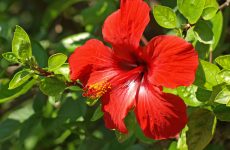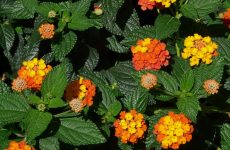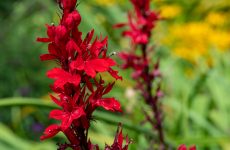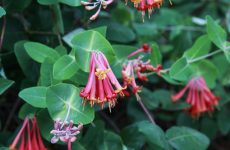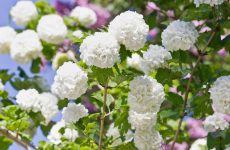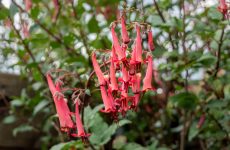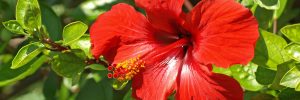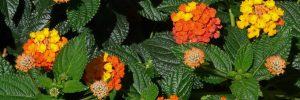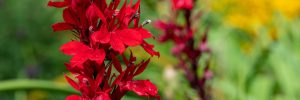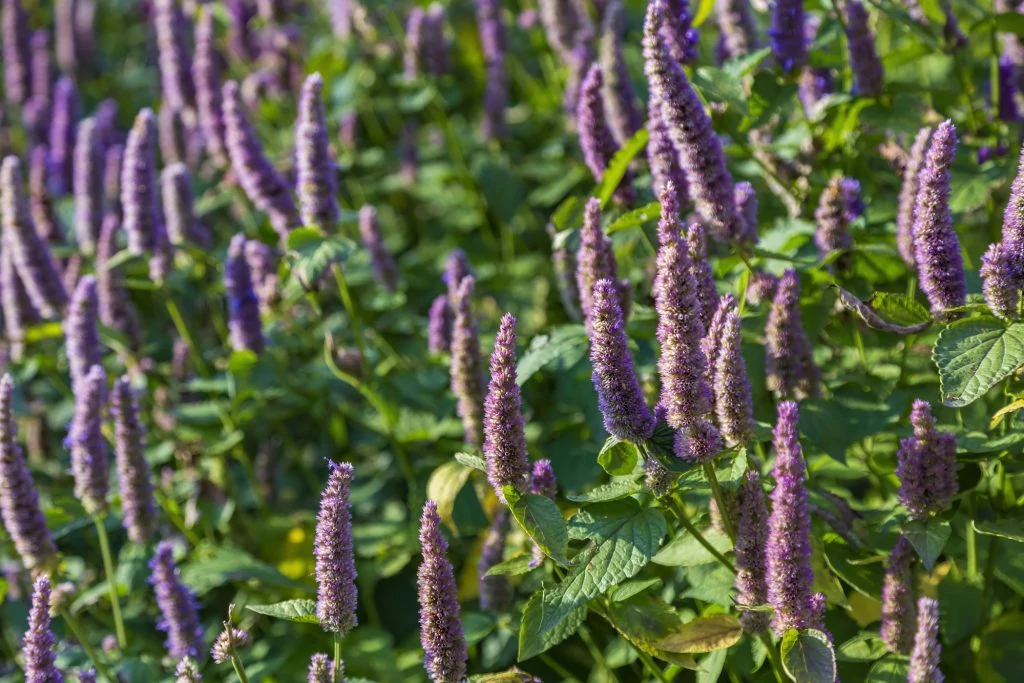
Hummingbirds don’t just go for red flowers as it’s the nectar the plants produce they are really interested in. So they are attracted to many different colored flowers.
Great news for you as you can create a gorgeous statement garden filled with purple flowers that hummingbirds love. You need to check the plant hardiness for your area and make sure the purple plants that you choose survive and thrive in your zone.
These plants may be available in many different colors, but they are available in purple varieties that you can fill your yard with to bring the hummingbirds flocking.
25 Purple Flowers That Hummingbirds Like:
1. Foxglove
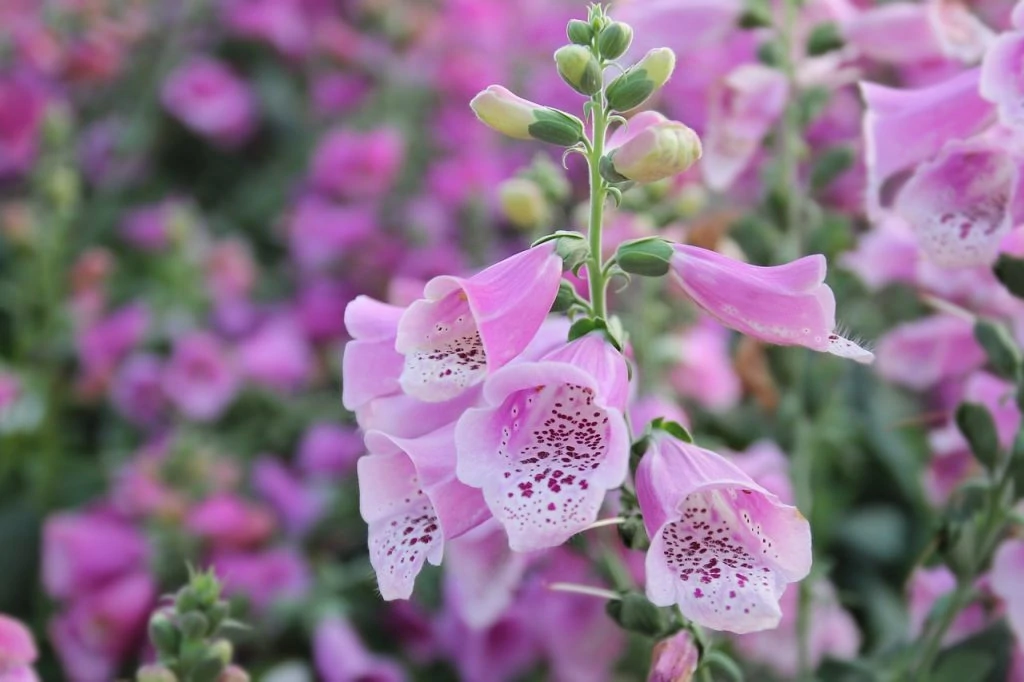
Foxglove is a beautiful woodland flower that grows dramatically tall stems with many bell-shaped blossoms. Due to the fact they are often found in woodlands, they are great shade-tolerant plants that hummingbirds’ long bills and tongues can reach into.
These are biennial plants, which means you need to plant them two years in a row as in their first year, they do not produce flowers and then die off after their second year of flowering. However, they readily self-seed, so you will get their dramatic display for many years.
Foxgloves are easy to grow from seed outside in late spring or late summer when temperatures are cooler.
- Common Name: Foxgloves
- Scientific Name: Digitalis
- Growing Zones: 4 – 8
- Sun: Full sun to partial shade
- Soil: Slightly acidic, well-drained but moist.
- Colors: Purple, pink, white
- Height: 5 foot
- Plant Type: biennials
2. Impatiens
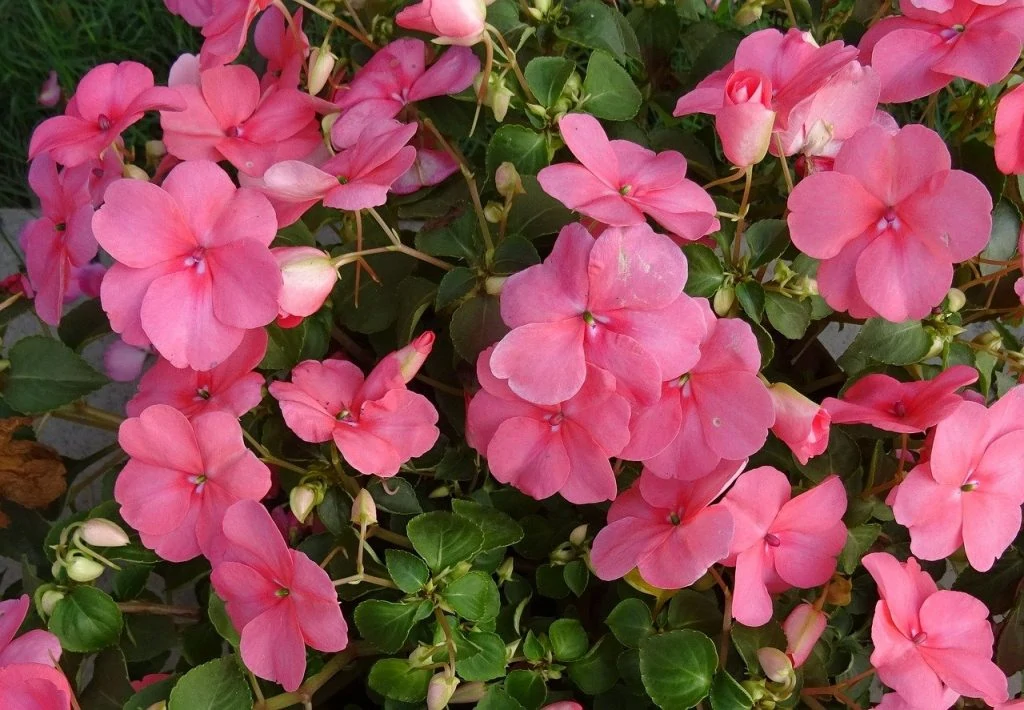
Bright and colorful annuals such as Impatiens are great at brightening up dark and shady areas, and these also attract hummingbirds.
They like moist and well-draining soil and deep shade, so hanging them on your porch will also work well.
Usually grown from plants bought in trays at nurseries and planted close together to create a dense mat of flowers and leaves.
Seeds can be collected from the plants and sown indoors 10 weeks before the last frost as they take a long time to flower. Cuttings can also be taken in the fall and grown indoors until the frost has passed.
- Common Name: impatiens, jewelweed, touch-me-not, snapweed, and patience
- Scientific Name: impatiens
- Growing Zones: 2 – 11
- Sun: Shade or partial shade
- Soil: Rich, well-draining
- Colors: Red, pink, purple, yellow, coral.
- Height: 6 – 36 inches
- Spread: 1 – 3 feet
- Plant Type: Annual
3. Petunias
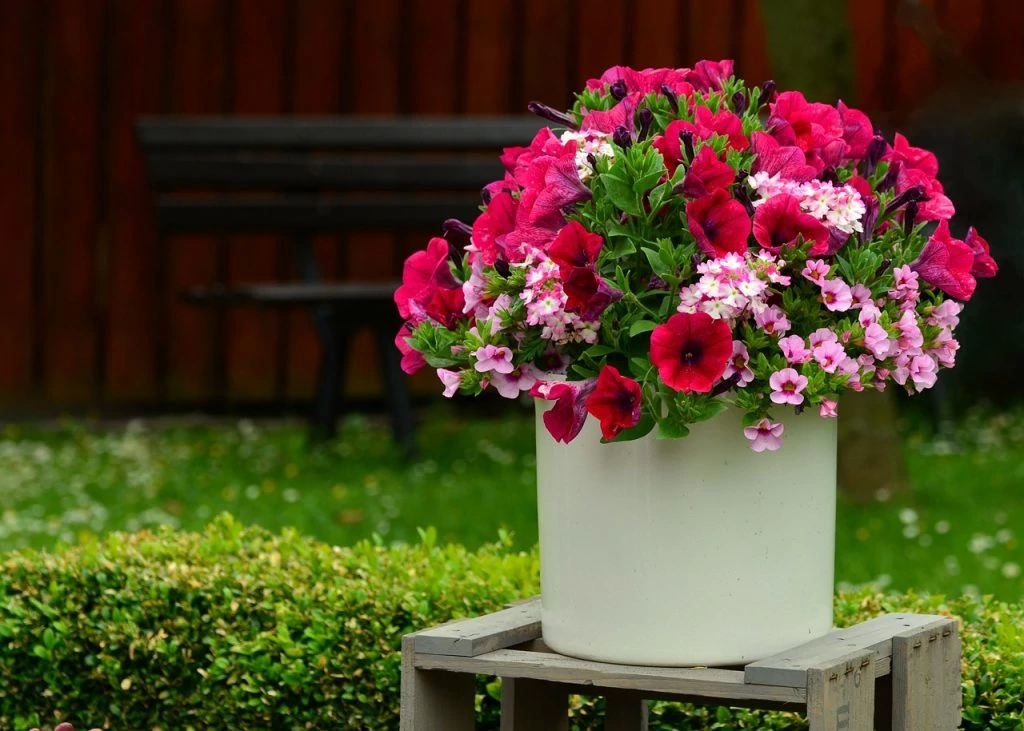
These colorful and inexpensive annuals are easy to grow in a sunny location, and they work great in a container. They create abundant flowers that look great tumbling out of pots and containers.
They are often sold as young plants in flats at a nursery, but you can also grow them from seed. If growing from seed, grow them ten weeks before your last frost date and then plant out once this risk has passed.
Petunias are quite heat-tolerant, but they should get a good soaking about once a week. Prune them to about half the height to prevent them from getting thin and leggy.
Try planting the brighter colors in the reds and pinks for hummingbirds.
- Common Name: Petunias
- Scientific Name: Petunias
- Growing Zones: 9 to 11
- Sun: Full Sun
- Soil: Well-drained moist soil
- Colors: Red, pink, white, blue, purple
- Height: 6 – 18 inches
- Spread: 18 inches to 4 feet
- Plant Type: Tender Perennial, Annual
4. Hyacinth Bean
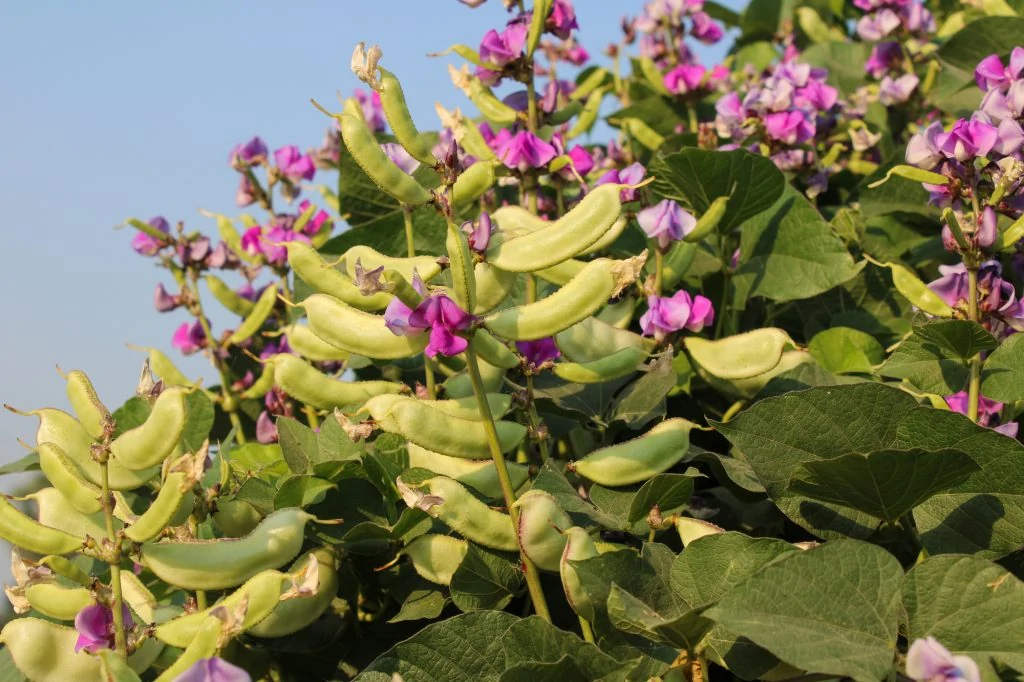
The Hyacinth Bean, or Lablab Purpureus, is a bean vine from the Fabaceae family. It is also known as Indian Bean, Egyptian bean, bataw, and Australian pea because although it is native to Africa, it is cultivated and used for food in Asia.
In the United States, it is commonly used as an ornamental plant because of its pinkish-lavender blossoms and equally captivating purple seed pods. It is also called the Jefferson Bean because Bernard McMahon, Thomas Jefferson’s nurseryman, apparently sold it to him in 1804.
To get the best quality flowers from the Hyacinth Bean, it is best to plant them as seeds in the backyard when the climate is warm in the spring. This will yield more flowers and grow more vines. Hyacinth bean vines can grow as tall as 25 feet when securely anchored to trellises and other types of support.
Flowers begin to bloom in summer through fall. They form clusters along the stalks, and they’re colored white, pink, lavender, or purple. Once the flowers are gone, the seedpods take over, and they’re also as pretty as the flowers. They’re purple, elongated, and have 2 -3 seeds per pod, but these are poisonous and not to be ingested.
Hummingbirds love these purple flowers, and it’s surprisingly easy to take care of. All you need is to give it a full dose of sunlight, just the right type of support to guide the vine on its path, and to provide regular watering for young plants before they’re established.
They can be perennial if the weather is mild, but if not, better treat it as an annual and make sure to keep some of the seeds so you can plant them during the next season.
- Common Name: Hyacinth Bean, Indian Bean, Egyptian bean, bataw, Australian pea
- Scientific Name: Lablab Purpureus
- Growing Zones: 4 – 9
- Sun: Full sun (no partial shade)
- Soil: Well-draining soil
- Colors: white, pink, lavender, purple
- Height: 10 – 25 feet
- Spread: 3 – 6 feet
- Plant Type: Annual
5. Clematis
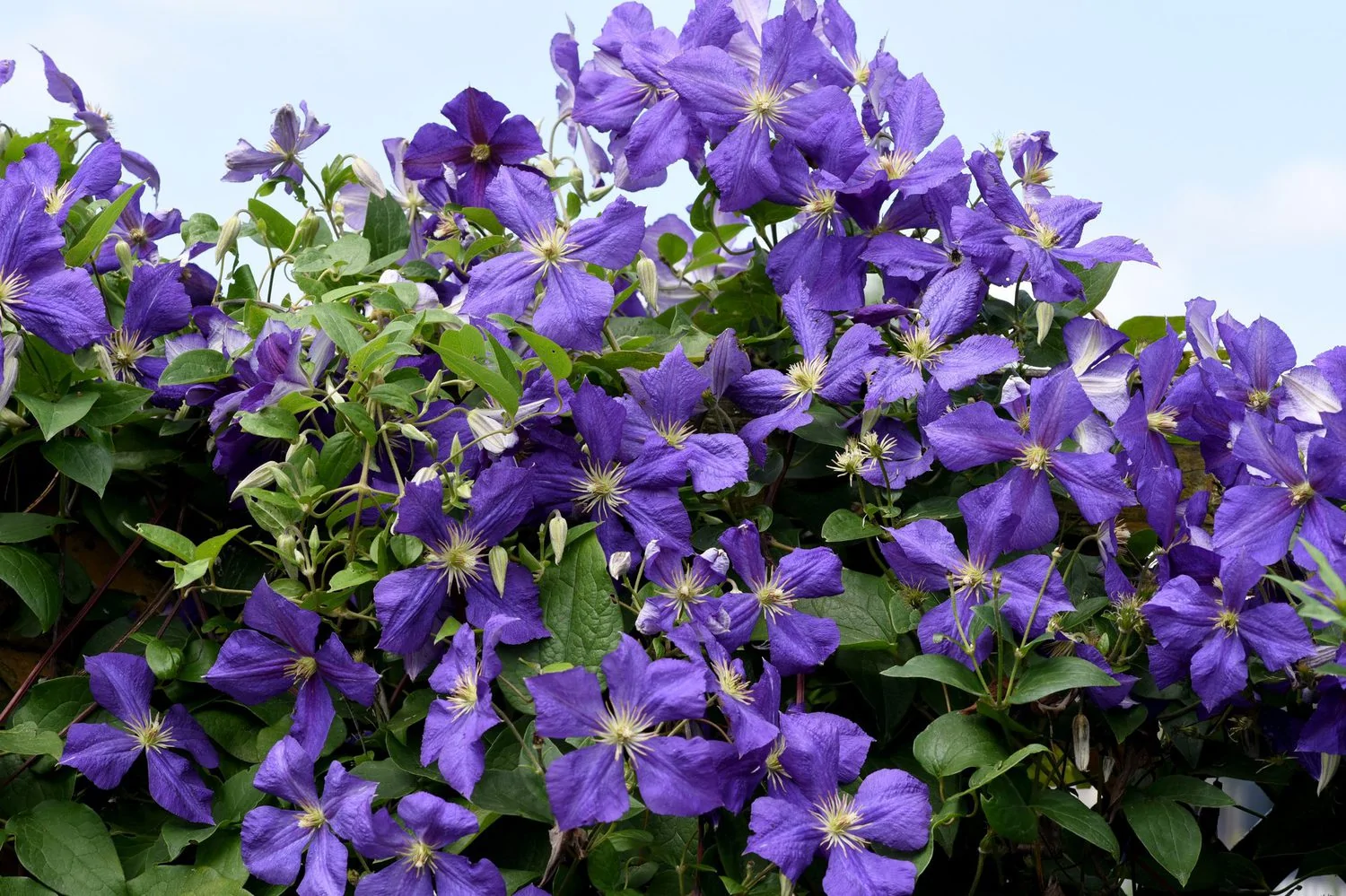
Clematis belongs to a large group of about 300 species of flowering vines under the buttercup family, Ranunculaceae. Originally from Japan and China, Clematis are among the most popular ornamental plants because they come in a variety of colors, there are many varieties suitable for your type of climate, and they never fail to attract hummingbirds and other pollinators to your backyard.
If you’re thinking of filling your trellis, arbor, or fence with beautiful and colorful flowers, then clematis are your best vine choice. They are mostly star-shaped flowers that come in large and small sizes. They have a wide range of colors – white, yellow, pink, blue, purple, and some are dual-colored, that bloom in spring or late summer, depending on the variety.
Aside from color, clematis also feature different flower types. There are flowers in loose clusters, bell-shaped flowers, and flat or open flowers. The large flowers are about 6-10 inches across and, with their color, are bound to attract hummingbirds and butterflies alike. Smaller varieties often have fragrances.
Clematis generally thrive under full sun, at the latest 6 hours of direct sunlight. What makes them different is that while they need that much sunlight, their soil needs to be constantly moist and must never dry up if you want gorgeous and plentiful flowers.
Depending on how tall you want your clematis to grow, pick a suitable support system for it. Larger clematis will be more suited for arbors, while smaller varieties can be grown on poles, fences, and trellises.
Give them space for their sunlight and shade for their roots. When they’re in flower, you’ll have a feast for your eyes, not just with the flowers but with all the hummingbirds that will visit your garden.
- Common Name: Clematis, woodbine, old man’s beard
- Scientific Name: Clematis
- Growing Zones: 4 – 8
- Sun: Full sun
- Soil: Moist, well-drained soil
- Colors: white, yellow, pink, blue, purple
- Height: 2 – 5 feet, 8 – 12 feet, 20 – 30 feet
- Spread:2 – 6 feet wide
- Plant Type: Perennial, Woody deciduous, herbaceous, and evergreen vines
6. Passionflower
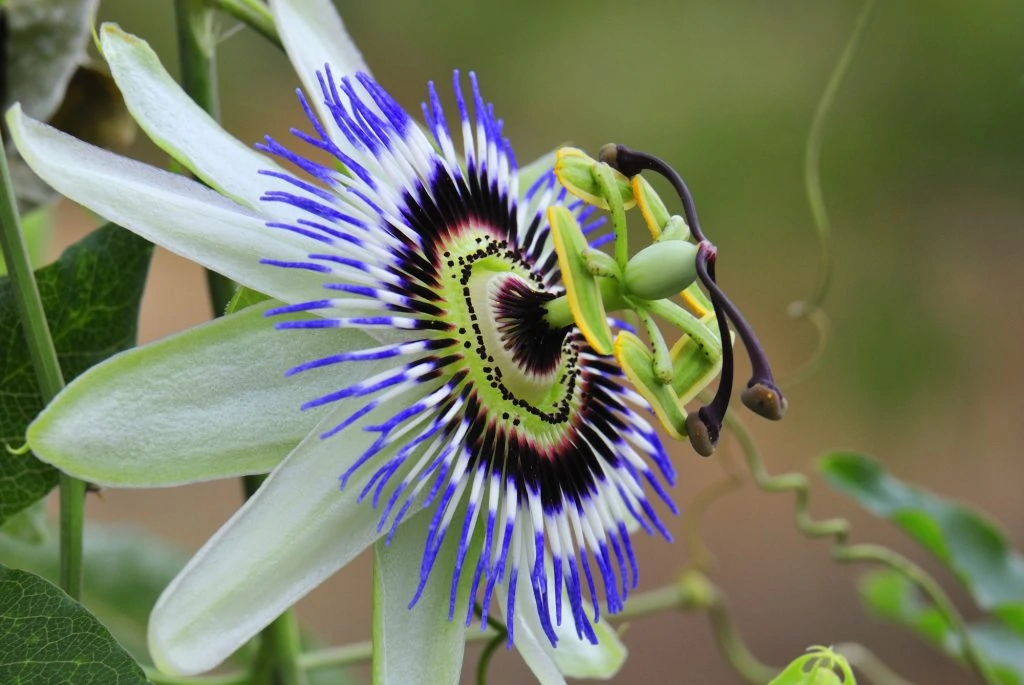
Passionflowers, or passion vines as they’re sometimes called, belong to the Passiflora genus with about 550 species of flowering plants. They’re characterized by having tendril vines and an exotic-looking floral structure that attracts pollinators like bees and hummingbirds. In fact, the Sword-billed Hummingbird evolved with the Passiflora mixta in order to extract nectar from its long corollas.
Passionflowers are unforgettable because they look exotic and alien. They are named passion flowers because their strange structure supposedly symbolizes the Passion of Christ.
Passionflowers are truly unusual creations that will look astounding in a pot or on trellises, walls, and fences. They have a variety of colors (white, pink, red, purple, blue) that thrive under full sunlight or at least 4 hours of it. Moist, well-drained organic soil also helps them grow fast and tall.
When a hummingbird successfully pollinates the flower, the fruit will start growing. The fruits are round or elongated, and depending on the variety of the passionflower they are edible. One passionflower, Passiflora incarnata, is commonly known as “Maypop” because it’s the sound of the fruit popping when crushed.
- Common Name: passionflower maypop, true passionflower, wild apricot, wild passion vine, passion vine
- Scientific Name: Passiflora
- Growing Zones: 5 – 9
- Sun: Full sun (at least 4 hours)
- Soil: well-drained, organic soil
- Colors: white, pink, red, purple, blue
- Height: 6 – 30 feet tall
- Spread:3 – 6 feet wide
- Plant Type: Perennial vine
7. Rhododendron
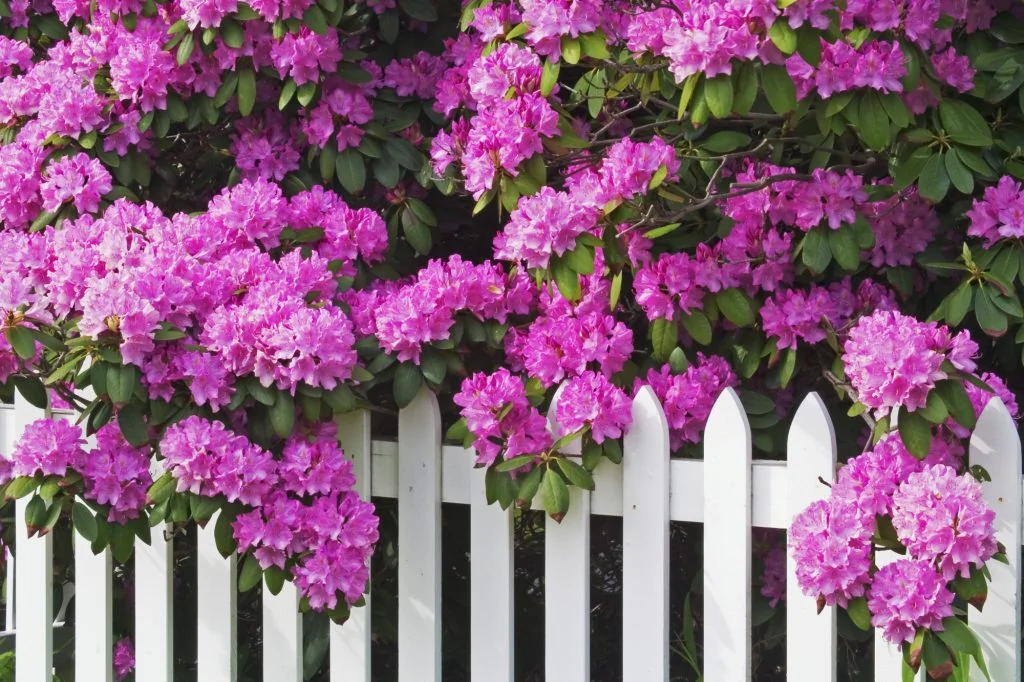
Rhododendrons are a large group of woody plants belonging to the heather family, Ericaceae. There are about 1,000 species of rhododendrons ranging from tiny shrubs to large trees. These evergreen shrubs are often used in ornamental landscaping because most hardy plants lose their leaves or die from the frost. They also have bright and colorful flowers.
It is easy to differentiate rhododendrons from azaleas, their most similar species. Most rhododendrons have bell-shaped, colorful flowers with ten stamens, while azaleas have one funnel-shaped flower with five stamens per stem. Rhododendrons have many flowers per stem, azaleas only have one, but since there are many stems to a shrub, this difference is hard to see.
With many varieties of rhododendrons, it is possible to plant and cultivate them all year long, especially if you have mild climates. However, early spring planting is your best choice when you live in an area with cold temperatures.
When you have hotter weather, early fall is the right time. Rhododendrons thrive better in environments that are not too hot and not too cold. You have to give them time to acclimate to the temperatures when you plant them.
Soil preparation for rhododendrons is important. You have to keep soil acidity between a pH of 4.5 – 5.5. Do a soil test to make sure. If the pH is too high, apply a small amount of agricultural sulfur or iron sulfate. However, if the pH is too low, apply ground limestone.
Allow rhododendrons to receive 6 hours of full sunlight when you live in colder climates (Zones 4-6) but give them ample shade when you live in hotter regions (Zones 7-11). Make sure they have well-irrigated soil and avoid getting the roots soaked in water.
Hummingbirds are attracted to rhododendrons because they have a variety of colors like pink, purple, red, white, and yellow.
- Common Name: Rhododendron
- Scientific Name: Rhododendron
- Growing Zones: 4 – 11
- Sun: Partial shade
- Soil: Well-drained, Acidic
- Colors: Pink, Purple, Red, White, and Yellow
- Height: 18 inches to 50 feet
- Spread: 2 – 3 feet
- Plant Type: Perennial
8. Native Buddleia – Butterfly Bush
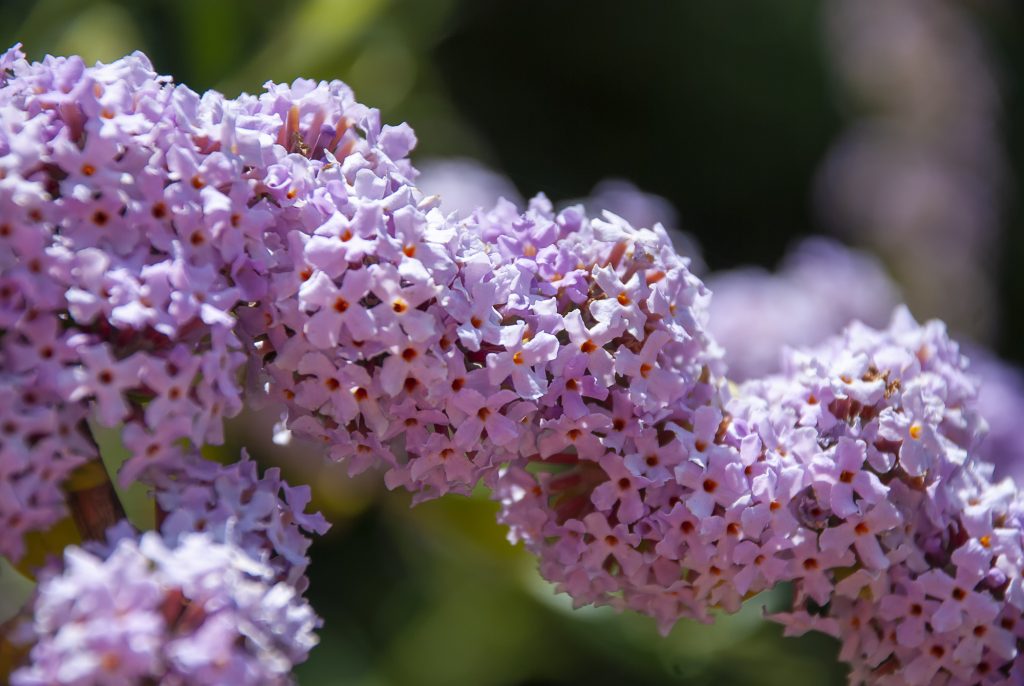
Buddleia or Butterfly Bush, with its striking purple, red, pink, white, and yellow pointed flowers, is a favorite ornamental plant if you want to attract butterflies (of course!) and hummingbirds to your backyard. They also produce nectar-rich flowers that are a surefire way to get hummingbirds to visit your backyard every time.
Buddleia refers to a family of over 140 species of flowering plants. They are more commonly called “butterfly bushes” because butterflies flock to them because of their nectar and honey-scented flowers.
The most common Buddleia variant is the Buddleia davidii which originates from China. Unfortunately, this species has been declared an invasive species in most US regions because it spreads its seeds and can grow unrestrained in natural areas. They tend to overcrowd native plants and have been deemed as a noxious weed. Be careful not to buy the purple davidii variety.
Butterfly bushes are low-maintenance plants. They are a hardy breed requiring full sun, so you might say they are pretty much drought-tolerant. However, during the first year, they would require regular watering as they’re trying to establish their roots. But once they’re firmly established, you only need to water them when the soil has become dry, like 2 to 4 inches deep.
The good news is, there are some Butterfly Bush variants that are sterile, and some species are available to grow in your pot or backyard, like Dwarf varieties that only grow up to 8 or 10 feet.
Some sterile or native varieties that you can grow are Rio Grande Butterfly Bush (Buddleia sessiliflora), Wand Butterfly Bush (Buddleia racemosa), Escobilla Butterfly Bush (Buddleia scordioides), and Fountain Butterfly Bush (Buddleja alternifolia).
- Common Name: buddleia, butterfly bush, and summer lilac
- Scientific Name: Buddleja
- Growing Zones: 5 – 10
- Sun: Full Sun
- Soil: Well-drained
- Colors: Pink, Purple, Red, White, and Yellow
- Height: 4 to 10 feet
- Spread: up to 5 feet
- Plant Type: Perennials, Evergreen
9. Cape Myrtle
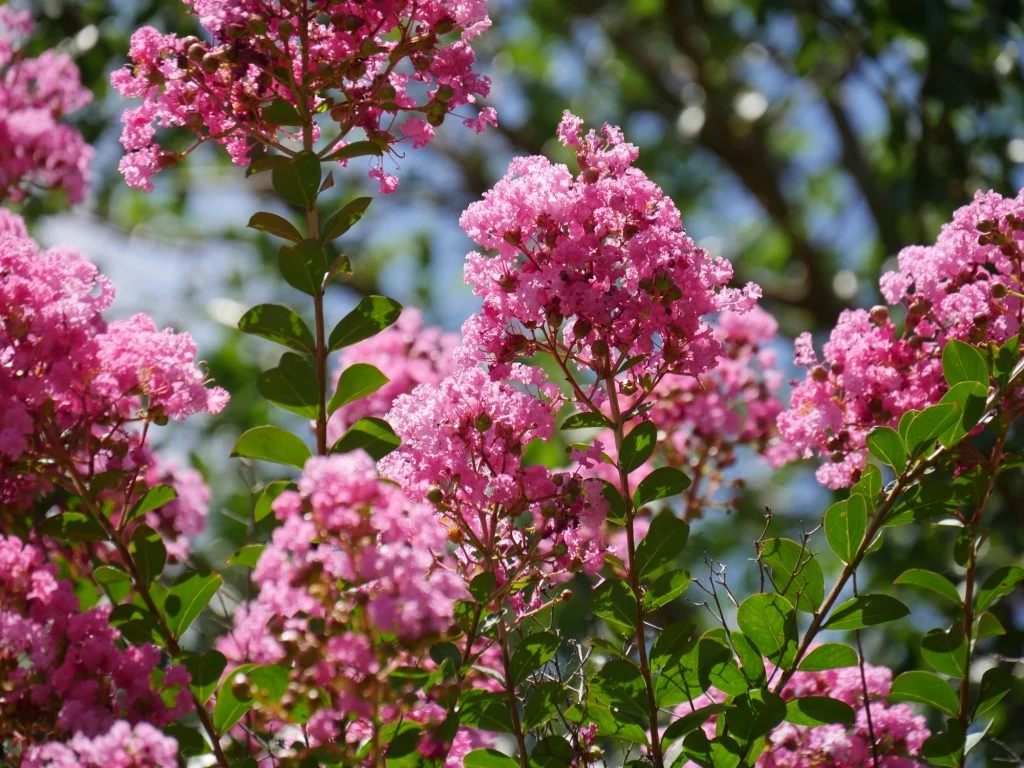
Crape Myrtle, or crepe myrtle, with the Latin name Lagerstroemia, belongs to the Lythraceae family. They are deciduous and evergreen shrubs originally from India, Asia, and Australia. They are sometimes called crepe myrtle because their flower petals have a crepe-like texture.
These Crape Myrtle trees or shrubs are brilliant additions to backyards because of their bright, large flowers, peeling bark in winter, and foliage that changes color in the fall. There are many varieties to grow, from single to multi-stemmed trees, smaller shrubs, and even dwarf trees as small as 2 to 5 feet tall.
Like most deciduous trees and shrubs, it’s best to plant them during fall or early spring to get their roots adjusted before the cold of winter or the heat of summer hits. They need at least 6 hours of full sunlight to encourage large, full blooms. They flower in mid-May and early June.
To ensure that your Crape Myrtle tree flower profusely, it is essential that you prune old and dead branches carefully. Give the new plants room to grow, so remove crisscrossing branches, short twigs, and branches that grow toward the center. Shrubs hardly need pruning except maybe to remove old and dead branches.
With their bright-colored flowers and a varying range of height, it’s easy to see why hummingbirds and butterflies love hanging around Crape Myrtles.
- Common Name: Crape Myrtle or crepe myrtle
- Scientific Name: Lagerstroemia
- Growing Zones: 7 – 10
- Sun: Full sun
- Soil: Moist soil
- Colors: dark purple, dark red, bright pink, magenta, and white
- Height: trees 15 – 20 feet, shrubs 5 – 7 feet
- Spread:trees 15 – 20 feet, shrubs 5 – 7 feet
- Plant Type: Perennial, Deciduous shrubs or trees
10. Agastache

Agastache, pronounced as (“ah-GAH-stuh-kee”), are aromatic herbaceous perennials with as many as 22 species, most of which are native to North America. They are commonly referred to as “hummingbird mints” and “Giant hyssops”. Aside from being a hummingbird magnet, they can also be made into herbal tea.
Agastache flowers are attractive to hummingbirds because they literally stand out from among the leaves. They are about 3 to 4 inches long and appear fuzzy because they’re made of many tiny flowers growing in clusters. Their striking purple and red colors are a hummingbird’s favorite colors, and they will be unable to resist flocking to Agastache flowers, especially when they’re in full bloom in the summer.
The best way to grow Agastache flowers is to start them as indoor plants in May and then transplant them into flower beds in the summer. They require full sun and regular watering when they’re still trying to establish themselves. However, once they’re done, they are drought-tolerant and can easily be left to their own devices.
Agastache are desert plants, hence they can tolerate even the hottest days. That is also the reason why it’s not necessary to keep watering them once they’re established. Too much water will rot the roots, so make sure to just give them a good splash and then leave them alone to dry.
- Common Name: Agastache, Hummingbird Mint, and Hyssop
- Scientific Name: Agastache
- Growing Zones: 3 – 10
- Sun: Full Sun
- Soil: Lean soil, well-drained
- Colors: Blue, purple, red, orange, pink, and white
- Height: 3 to 5 feet tall
- Spread:
- Plant Type: Herbaceous perennial
11. Salvia
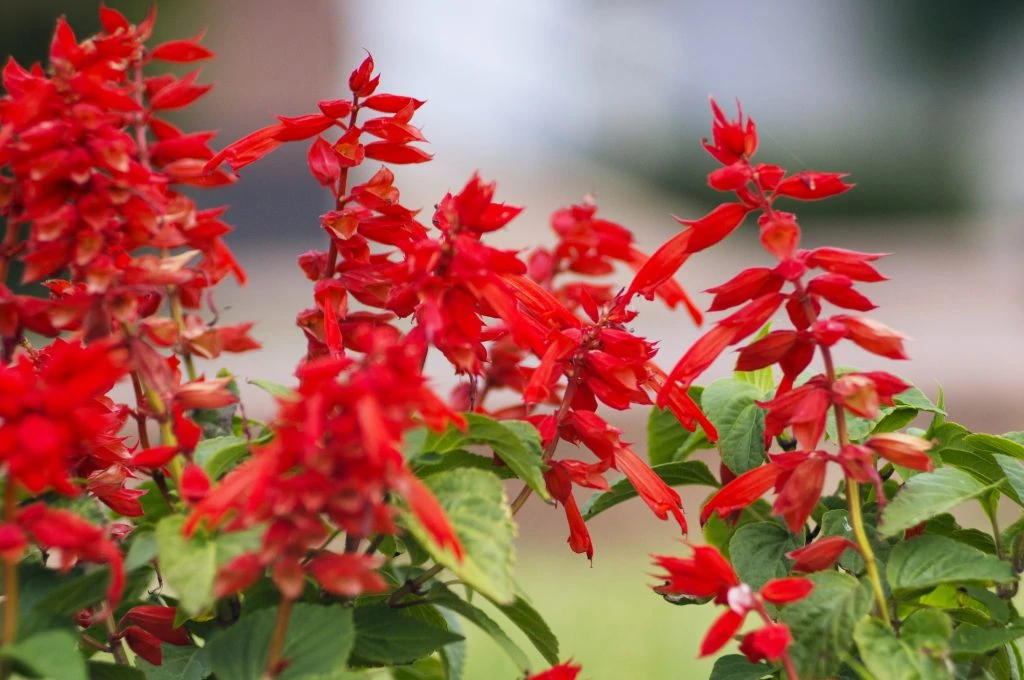
With over 1000 species of these members of the mint family, salvias are a great perennial to choose for hummingbirds. They are also drought-resistant and easy to care for.
Salvias evolved alongside hummingbirds in the Americas, and they use the hummingbirds’ long bills to enter the flower and open a trapdoor that deposits pollen on their heads and rewards them with rich nectar.
They put on a rich display of flowers and tubular blossoms all summer that keep the hummingbirds coming back.
Many native species of salvia are drought tolerant and grow happily in the heat of the South. Although salvias are heat and drought tolerant, if it is very dry, then water thoroughly once a week.
Sometimes known as sage plants, they can be grown as annuals, but also perennial varieties are available. Deadhead them during the summer to encourage more flowers but leave flowers on at the end of the season, so they reseed.
Choose Salvias with red, pink, and orange-colored flowers. Native species are best, but Salvias from Europe are hardier and will grow further north, extending the range and nectar availability for hummingbirds.
- Common Name: salvia
- Scientific Name: salvia
- Growing Zones: 4 – 10
- Sun: Full sun, but some will tolerate partial shade
- Soil: Well-drained
- Colors: Red, pink, purple, blue, white, yellow.
- Height: 1 – 6 feet
- Spread: 1 – 6 feet
- Plant Type: Annual, Perennial
12. Penstemon
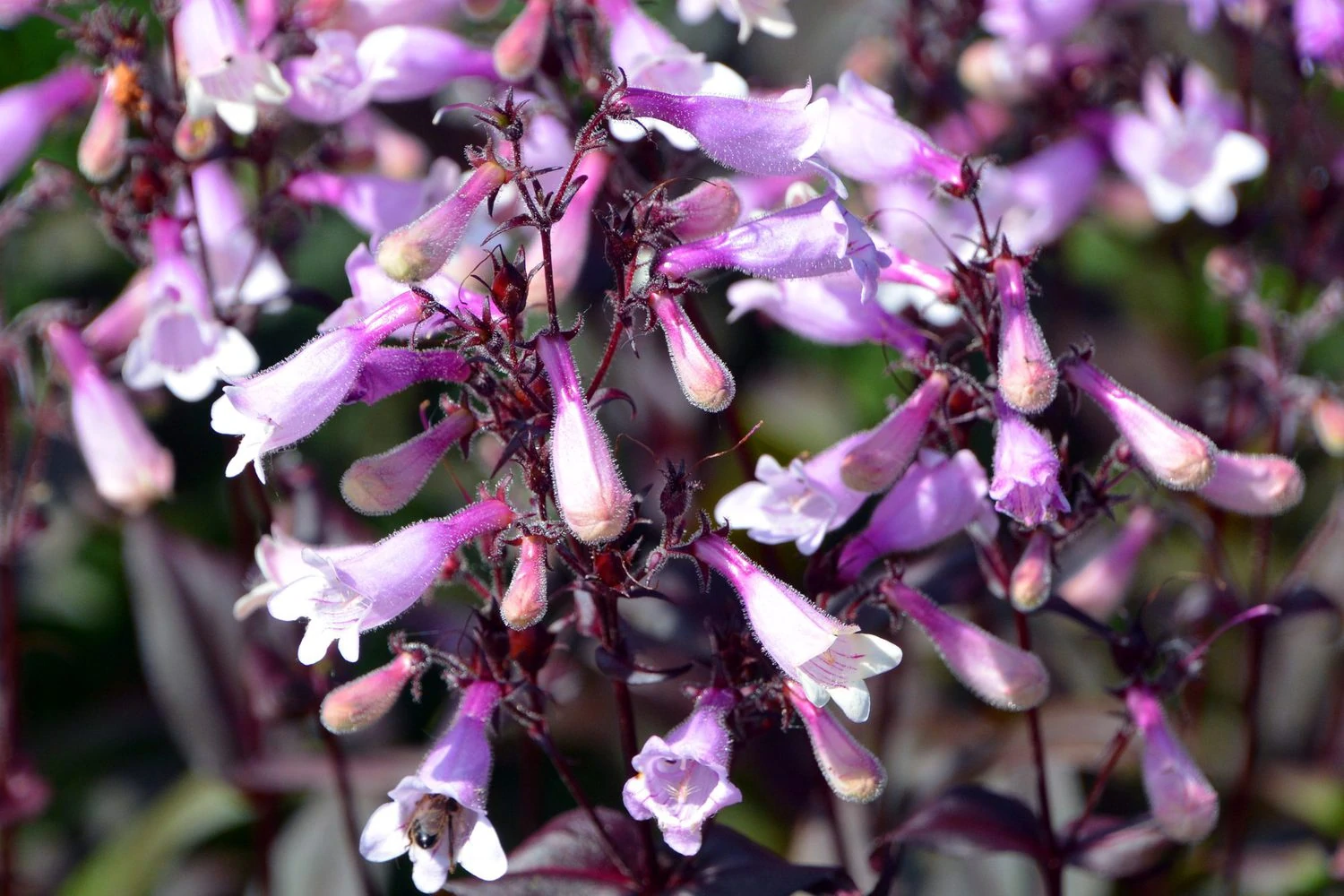
Penstemon is a genus belonging to the plantain family (Plantaginaceae), with over 250 different ornamental flowering plants, like snapdragons and foxgloves. It is also called Beardtongue because the pollen-free stamen that protrudes from the flowers has a tuft of small hairs.
With a wide number of species, there are many varieties of Penstemon to choose from to suit your backyard. They may have different sizes and different colors, but they all share these things- they’re all drought-tolerant, they attract hummingbirds and bees, they’re easy to take care of, and their lovely blooms brighten up any backyard.
Flowers of the Penstemon genus bloom in early summer. They become a focal point in a garden setting because of their spires and a colorful cluster of tubular flowers. There are many colors to display depending on the variety you’ve chosen. There are blue, purple, red, orange, white, pink, and yellow.
Hummingbirds always flock to Penstemon because they’re bright and colorful, and they’re nectar-rich.
The best place to plant penstemons is where they can get full sunlight. Flowers will bloom profusely, and stems will remain upright instead of drooping because of shade. They prefer nutrient-poor soil with moist conditions. They can tolerate drought, but it’s also good to give them a good watering every once in a while. It’s better to choose a variety suited to your soil condition and climate to make them last longer.
- Common Name: penstemon, foxglove beard-tongue, foxglove beardtongue, talus slope penstemon, and white beardtongue
- Scientific Name: penstemon
- Growing Zones: 3 – 9
- Sun: Full sun
- Soil: lean, fast-draining soil
- Colors: Blue, Purple, Red, Orange, White, Pink, Yellow
- Height: 6 to 12 inches, 1 to 3 feet, 3 to 8 feet
- Spread: 8 to 20 inches
- Plant Type: Perennial
13. Fuchsia
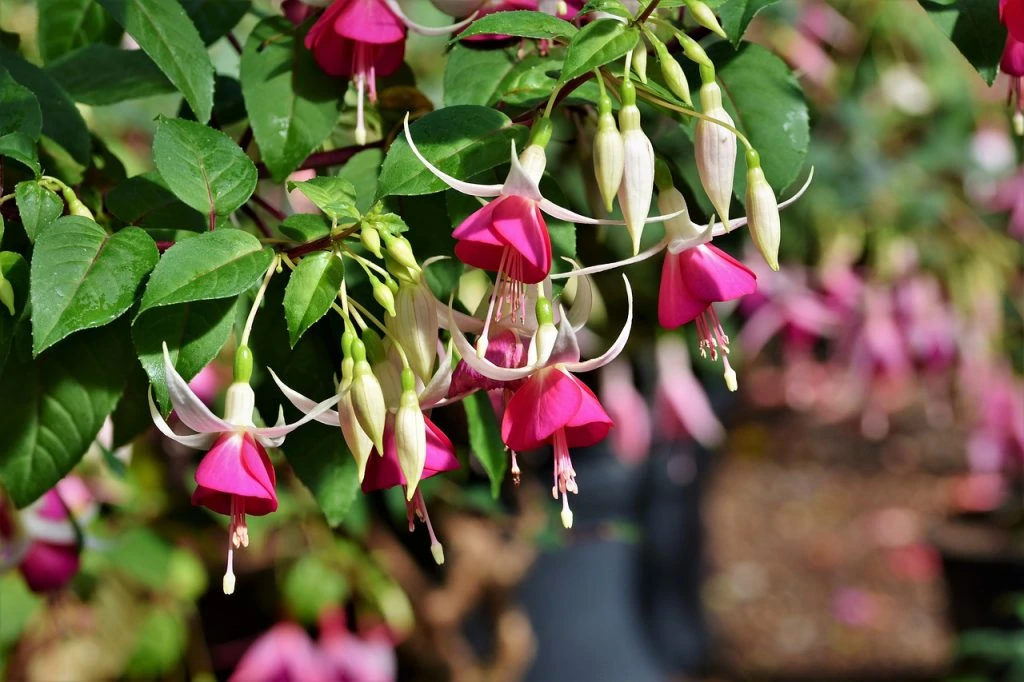
Fuschias are bright hardy perennials that provide nectar for hummingbirds all through the summer. They look especially great in pots and containers, with their beautiful flowers abundantly drooping over the sides.
Fuschias come in hardy varieties and are easy to grow in most soils. They require very little maintenance and so are a great addition to your garden.
They prefer dappled shade and not too much heat and will brighten up a more shady area of your patio.
Pinch off growing tips after flowering and fertilize every two weeks in the growing season. In colder areas, they may need to be brought inside in the winter.
- Common Name: Fuschia
- Scientific Name: Fuschias
- Growing Zones: 6 – 11
- Sun: Partial sun to shade
- Soil: well-drained moist soil
- Colors: Pink, purple, white, orange, and blue
- Height: 1 – 3 feet
- Spread: 1 – 5 feet
- Plant Type: Perennial
14. Eastern Redbud
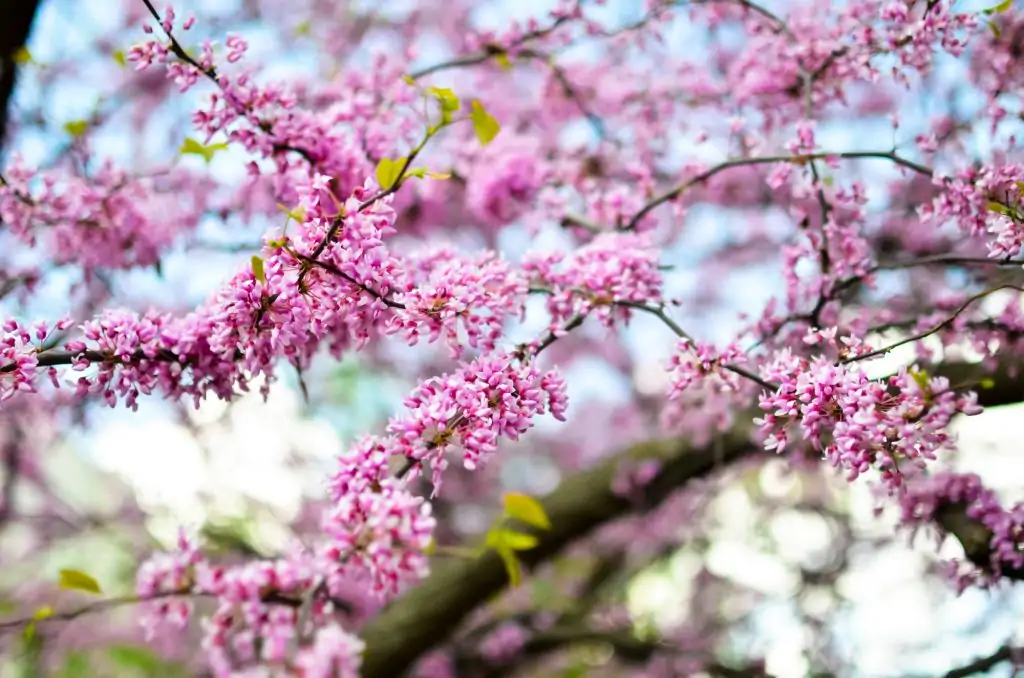
The Eastern Redbud, Cercis Canadensis, is a large deciduous shrub or small tree native to eastern North America. It is grown as an ornamental specimen plant for its twisted trunk, zigzag branches, beautiful flowers, and large, heart-shaped leaves. It is also just the right size for a small to medium backyard.
What makes the Eastern Redbud interesting is that its flowers appear before the leaves when they bloom in early spring. So, they’re really the focal point of the tree once they start flowering. The half-inch wide flowers grow in clusters on the branches, each with 4-8 flowers. Only hummingbirds and long-tongued bees, like blueberry bees and carpenter bees, can reach the nectaries.
Eastern Redbud flower colors range from light pink to deep magenta, and some even have a purplish tinge. With their bright colors against the dark branches and trunk, the flowers appear to be just floating in the air in the right kind of light. You can enjoy this display for 2 to 3 weeks before the fruits appear.
Once the flowers disappear in mid-summer, their fruits or legumes appear. They look like bean pods that start out green when they first come out but will, later on, turn brown as winter approaches.
Leaves then appear as winter buds, initially bright green with a tinge of red, and when they unfurl and expand, they are heart-shaped. They are bright green, glossy, and have prominent veins.
Eastern redbuds can be grown in full sun and partial shade, but if you want them to bloom profusely, it’s better to give them 6 hours of sunlight. While they may tolerate drought, it’s still better to keep them watered regularly. You may also prune them while young to give them shape and structure.
- Common Name: Eastern Redbud
- Scientific Name: Cercis Canadensis
- Growing Zones: 4 – 9
- Sun: Full sun, partial shade
- Soil: moist, well-drained soil
- Colors: pink, reddish, purple
- Height: 20 to 30 feet tall
- Spread: 25 to 35 feet wide
- Plant Type: Perennial, Deciduous tree
15. Morning Glory
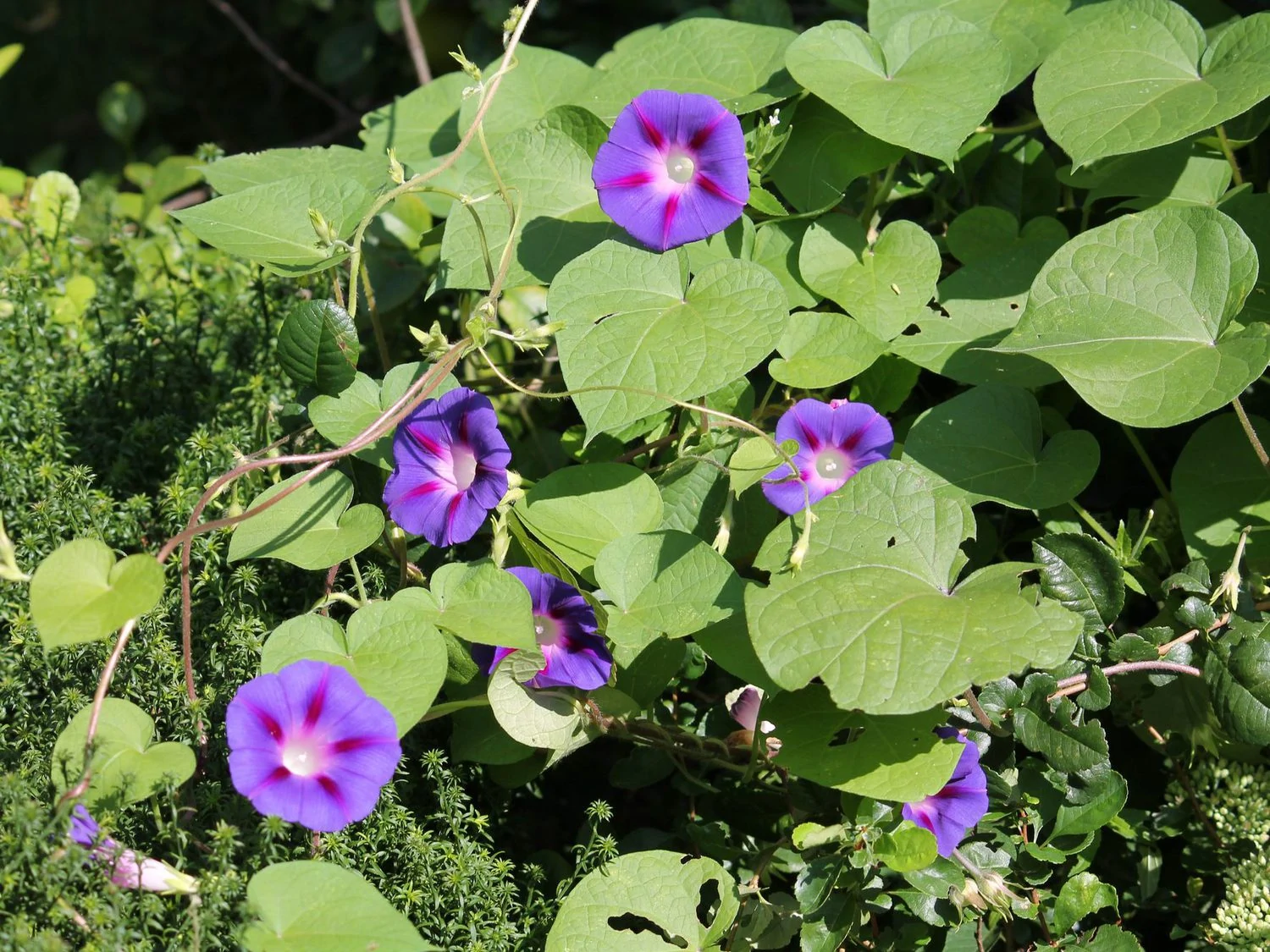
The term “Morning Glory” is the catchphrase for over 1,000 species of flowering plants from the Convolvulaceae. They are referred to as Morning Glory because the flowers open up early in the morning and close up in the heat of the day. However, there are some species that belong to the Morning Glory family that bloom at night instead of the day, like Ipomoea alba.
Morning glory flowers are characterized by bright and colorful blooms, fast-growing vines, bright green foliage, and tolerance for poor and dry soils. They are often twined around arbors or allowed to crawl along the house’s exterior walls with a trellis.
One of the popular Morning Glory species that is known to attract hummingbirds is Ipomoea purpurea. It has bright purple, trumpet-shaped flowers and heart-shaped leaves that open in the morning and close in the afternoon. They bloom from early summer to early fall.
Morning glory is an annual vine but may be considered a perennial in milder climates. It is important to expose Morning Glories to full sun, at most 8 hours of sunlight daily, to get them to fully bloom.
Morning glories may end up being an invasive species if you don’t take care of the fast-growing vines. Its seeds are also toxic if eaten, so children and pets shouldn’t be allowed to get near the plant.
- Common Name: Morning Glory, common morning glory
- Scientific Name: Convolvulaceae family
- Growing Zones: 2 – 11
- Sun: Full sun
- Soil: Moist, well-draining
- Colors: white, pink, purple, blue
- Height: 6 – 10 feet tall
- Spread: 3 – 6 feet wide
- Plant Type: Annual
16. Flowering Tobacco
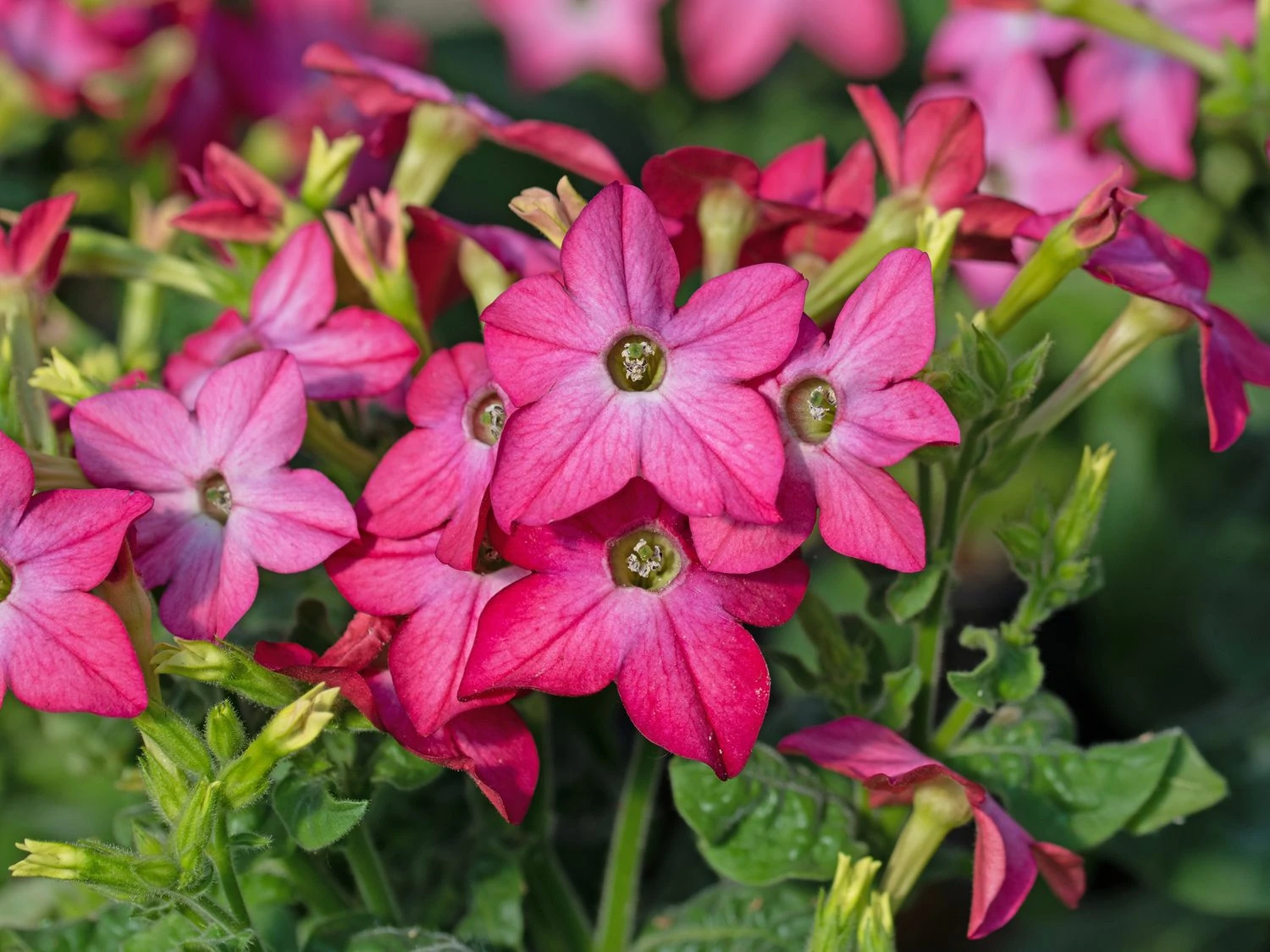
Flowering tobacco plants belong to the family Nicotiana, a group of herbaceous tobacco plants. They are relatives of the true tobacco plants, are usually grown as ornamental plants, and come in different varieties.
If you want fragrant flowering tobacco plants in your garden, you may opt for Nicotania sylvestris or Nicotiana alata, two of the more common and popular varieties. They emit a jasmine fragrance every evening.
Nicotiana sylvestris have wide, oblong leaves and in the center of it rises a central flower spike that can grow several feet tall. There are many tubular, pendant, white, or cream flowers that bloom from June until the first frost. Nicotiana alata plants are also tubular, but they bloom from tall, graceful stems. Their flowers are white and star-shaped and emit sweet perfume at night.
These types of flowering tobacco are easy to plant and grow, requiring full sun or part shade and well-draining soil. What’s more, they’re a great attraction for hummingbirds with their tube-like flowers and fragrance.
However, they may be short-lived since they’re considered annual plants. But, they’re self-seeding, so you can continue to enjoy them for the following year. Just make sure to protect them from the cold and extreme heat.
- Common Name: Flowering tobacco, Jasmine tobacco
- Scientific Name: Nicotiana family
- Growing Zones: 10 – 11
- Sun: Full sun to part shade
- Soil: organically-rich, moist, well-draining
- Colors: white, yellow, pink, red, yellow-green, purple
- Height: 6 to 12 inches, 1 to 3 feet, 3 to 8 feet, 8 to 20 feet tall
- Spread:6 inches to 10 feet, depending on the variety
- Plant Type: Annual
17. Zinnia
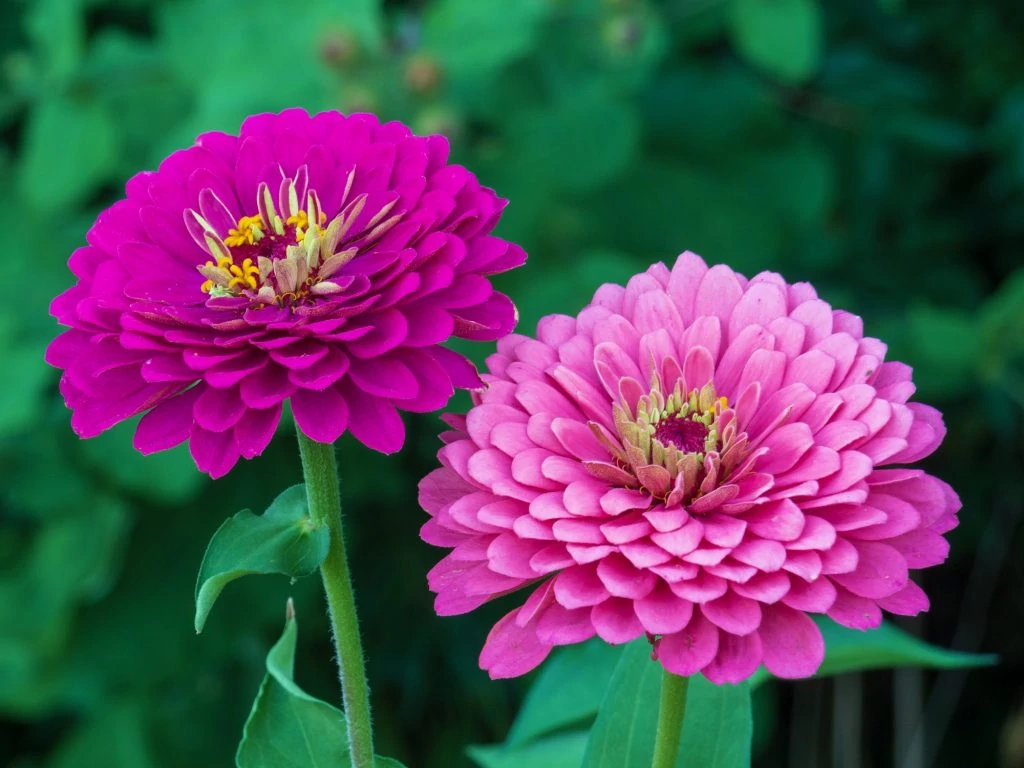
Zinnias are flowering shrubs native to the scrub and dry grasslands of North America. They belong to the genus Heliantheae or the sunflower tribe and to the much larger daisy family, Asteraceae.
There are three main types of zinnias based on the kind of petals that they have. Single-flowered zinnias have a single row of petals with a visible center. Double-flowered zinnias have numerous rows of petals with no visible center. Semi-double-flowered zinnias have numerous rows and visible centers.
The Zinnia elegans, with its tall stems and bright colors, is considered a classic and is most popular for backyards and gardens. It reaches 4 feet tall, has many brilliantly-colored flowers, has a long blooming period from early summer to frost, and attracts pollinators like butterflies and hummingbirds.
Growing zinnias is easy, but you have to plant them directly where you want them because they don’t like being transplanted. But once they become established under full sun and well-draining soil, you will be able to enjoy their bright blooms for a long time.
- Common Name: Zinnea, Zinnia
- Scientific Name: Zinnia elegans
- Growing Zones: Annuals in 2-8, Perennials in 9-11
- Sun: Full sun
- Soil: neutral to slightly alkaline, well-draining
- Colors: white, yellow, orange, pink, red, purple
- Height: 1 – 4 feet tall
- Spread:12 – 18 feet wide
- Plant Type: Annual, Perennial Shrubs
18. Daylily
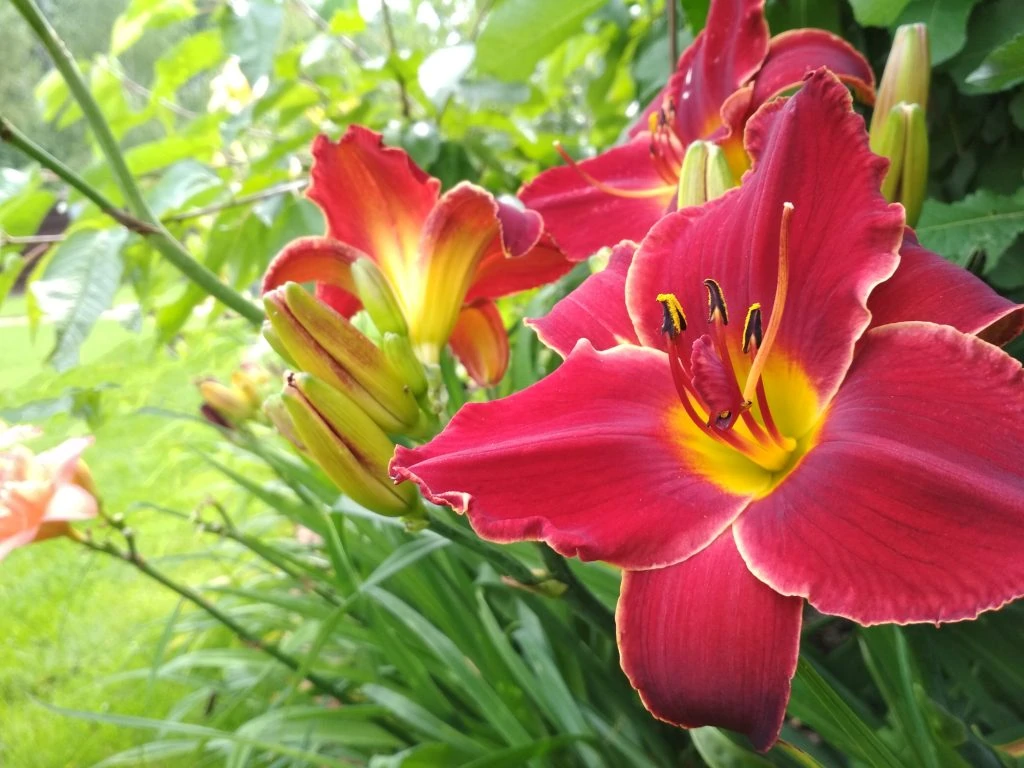
Daylilies are perennial plants from the family Asphodelaceae, popular among gardeners because of their attractive flowers. As many as 35,000 cultivars have been developed in order to create more variants with varying colors, plant hardiness, plant disease resistance, and plant sturdiness.
Daylilies are not true lilies, despite their name. They grow from fleshy roots, not from onion-like bulbs. Their flowers also form on “scapes” or leafless stems that can have as many as 12-15 buds on them. Each mature daylily plant can have 4 to 6 scapes, so you can have plenty of blooms for many seasons.
But, true to their name, daylily flowers only last a day. The good news is that a new flower grows after so that each plant, with its many scapes, can have a lot of blooming flowers from mid-spring to fall.
In order to keep the Daylily plant blooming its brilliantly-colored flowers, they have to be placed in an area that will receive at least six hours of sunlight. While they are drought-tolerant, it’s important to keep them hydrated with water, especially when the scapes and buds are still forming.
Hummingbirds are easily attracted to daylilies because of their bright colors, particularly the reds and purples. They are drawn to the tubular varieties, too because those are the flowers that hold the most nectar.
- Common Name: Daylily
- Scientific Name: genus Hemerocallis
- Growing Zones: 4 – 9
- Sun: Full sun
- Soil: Slightly acidic to neutral
- Colors: white, yellow, orange, pink, red, purple
- Height: 3 to 4 feet tall
- Spread: 2 to 4 feet wide
- Plant Type: Perennial
19. Calibrachoa
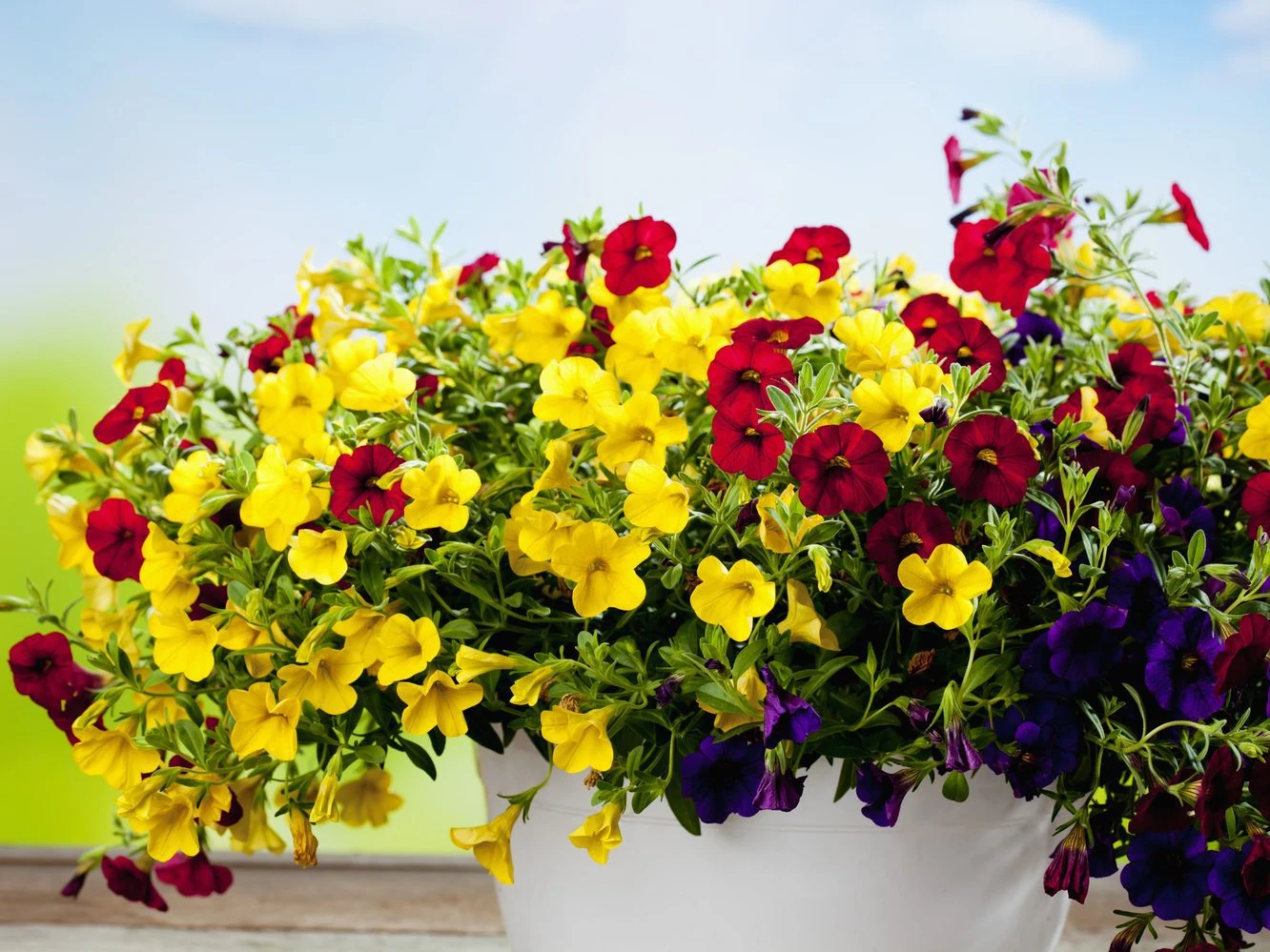
Calibrachoa, more commonly known as million bells or trailing petunia, are small shrubs belonging to the Solanaceae family. They are a relatively new species of ornamental plants, having been introduced only in the 1990s. But they’ve grown popular because of their prolific, colorful blooms that look like small petunias, which is why they’re also called mini petunias.
Calibrachoa plants are well-suited for containers and hanging baskets since they grow so fast and have a tendency to cascade. They can only grow to as high as 12 inches, but they do give you so many flowers you’ll hardly see any foliage.
The flowers of the Calibrachoa plant are small, bell-shaped, and pretty colorful. They come in shades of coral, yellow, orange, red, pink, blue, purple, burgundy, lavender, and cream. There are even varieties that give you dual-colors and veined and segmented petals. Regardless of the diversity of the flowers, calibrachoa flowers attract pollinators like hummingbirds.
They are not hard to grow and maintain. Calibrachoa grows well in full sun and well-draining soil. Just pay attention to the weather because if it gets too hot, you may need to adjust the amount of water that you give them.
- Common Name: Calibrachoa, million bells, trailing petunia, mini petunia
- Scientific Name: Calibrachoa
- Growing Zones: 9 – 11
- Sun: Full Sun to Part Shade
- Soil: Moist, rich, well-drained
- Colors: coral, yellow, orange, red, pink, blue, purple, burgundy, lavender, cream
- Height: 6 – 12 inches tall
- Spread: 12 – 24 inches wide
- Plant Type: Perennial
20. Delphinium
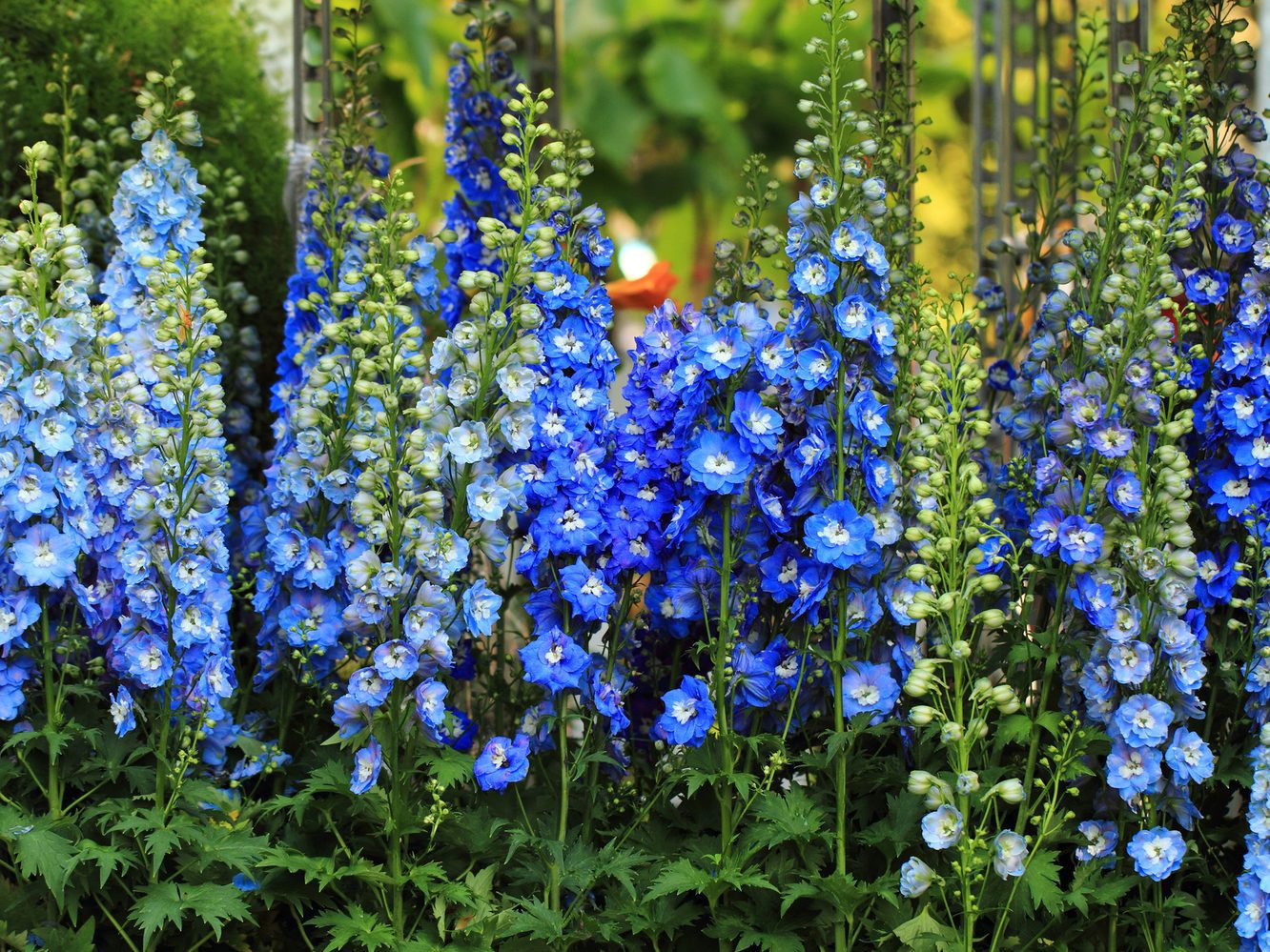
Delphiniums are a genus of about 300 species of flowering plants belonging to the family Ranunculaceae. They are known for their striking, tall, colorful, nectar-rich flowers that are a feast for butterflies, bees, and hummingbirds.
Many gardeners love to plant delphiniums mainly because of their rare blue flowers despite their toxicity and somewhat tricky growing conditions. But, if you’re looking for other colors, delphiniums won’t disappoint because they also have them in pink and red. You can enjoy these flowers from late spring to late summer.
Delphiniums can grow to a height of 8 feet tall in some variants. Their foliage is attractive as well, with their small, palm-shaped leaves. These plants flower well in full sun. It may need to be shielded from too much heat though, and very strong winds. As they grow vertically, you may need to create some support for their stalks, too.
These flowers grow profusely for every stalk and within each flower is a stockpile of nectar that attracts hummingbirds to them. The bright colors of the flowers are already a huge attraction, but having that much available nectar is guaranteed to draw in pollinators repeatedly.
- Common Name: Larkspur, Delphinium
- Scientific Name: Delphinium
- Growing Zones: 3 – 7
- Sun: Full sun, part shade
- Soil: well-draining soil
- Colors: white, pink, red, purple, blue
- Height: 1 to 3, 3 to 8 feet tall
- Spread: 1 to 3 feet wide
- Plant Type: Perennial
21. Lupine
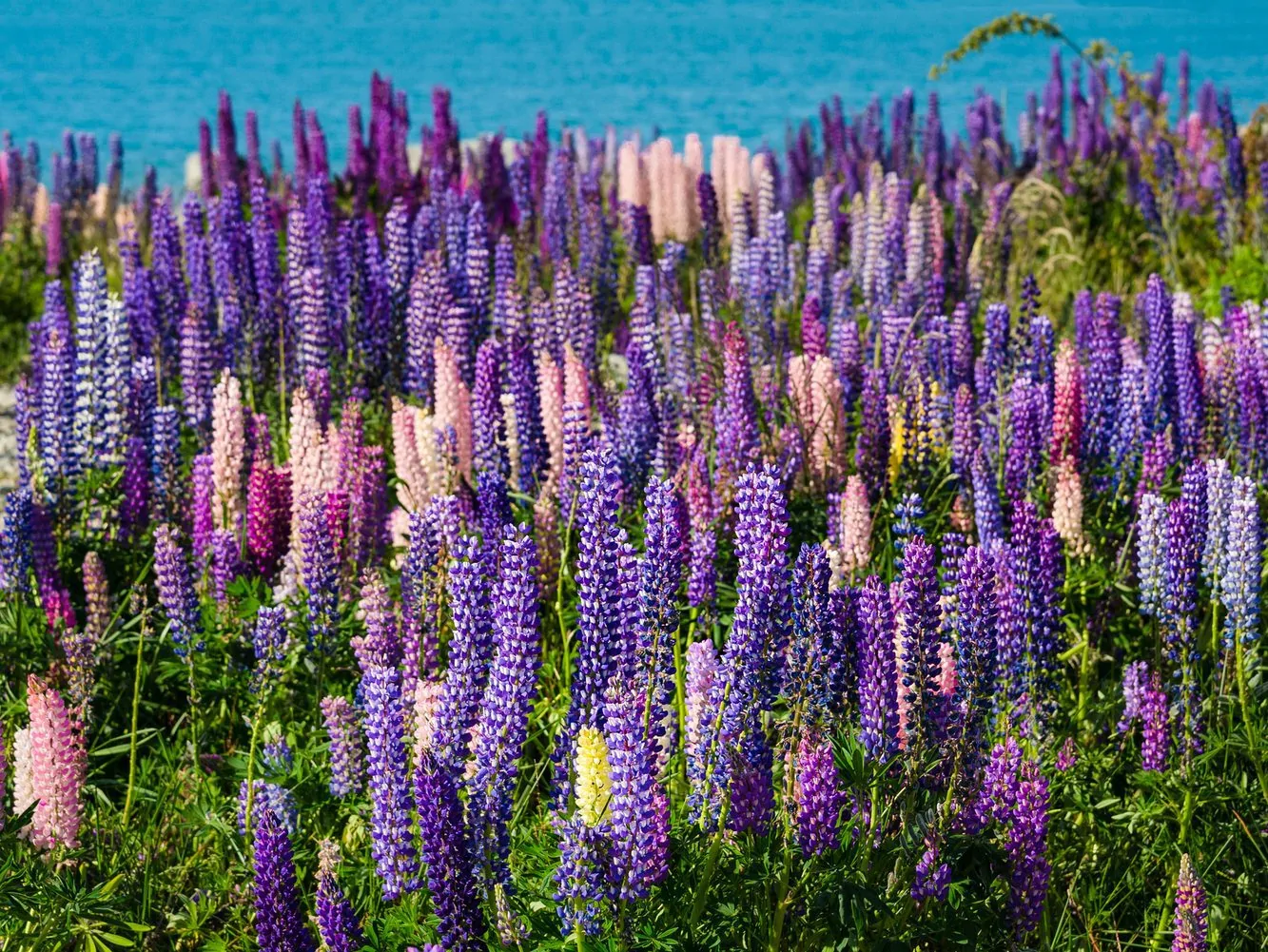
Lupine, or its scientific name Lupinus, comes from the family Fabaceae and is cultivated as an ornamental plant and as a food source, despite having some toxicity that can induce allergic reactions in humans and animals.
It was originally named “lupinus” because it was thought to be “wolfing” the nutrients of the soil. But in truth, it is a nitrogen-fixer plant, meaning it naturally adds nitrogen to the soil. So, if you have any plants that need nitrogen as a fertilizer, Lupines will naturally provide it for you.
With over 199 species of flowering plants, Lupines have such a diverse array of flowers. The Texas bluebonnet (Lupinus texensis) is one popular variant in the United States because of its prolific blue flower spikes. It is also why lupine is known as bluebonnet, too.
Lupines are easily recognizable because of their tall, vertical spiky flowers. Wild ones are often blue and white, while garden-variety ones come in blue, yellow, pink, red, and purple. These colorful hybrids originated from Lupinus polyphyllus and crossed with other variants.
Lupines, with their bright, numerous flowers, are a magnet for hummingbirds. They bloom in early spring when most other flowers are still in the process of growing, and that quality attracts hummingbirds because they’re the only food source available.
- Common Name: lupin, lupine, bluebonnet
- Scientific Name: Lupinus
- Growing Zones: 4 – 8
- Sun: Full sun
- Soil: Rich, moist, well-drained
- Colors: white, pink, red, yellow, blue, purple, bicolor
- Height: 3 – 4 feet tall
- Spread: 1 – 1.5 feet wide
- Plant Type: Annual, Perennial
22. Bee Balm
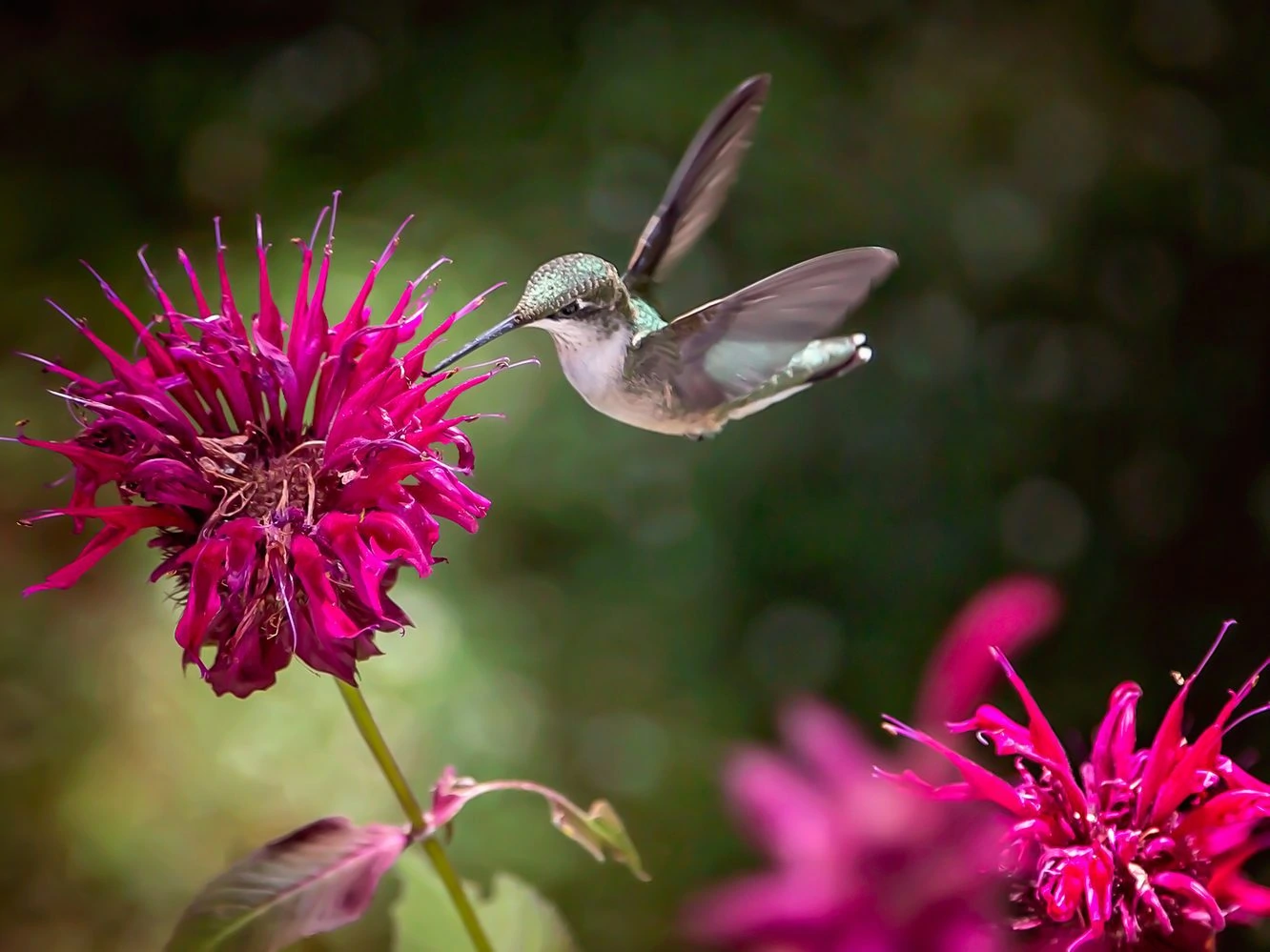
Bee Balm comes from the Monarda mint family, Lamiaceae. It is called “Bee Balm” because Native Americans used it as an antiseptic salve for treating bee stings. Its “Oswego Tea” name is also a result of the Oswego Native Americans brewing its leaves for tea.
Monarda plants are not just popular for their minty aromatic leaves but also for their brightly colored, exotic-looking flowers that are a guaranteed magnet for hummingbirds. Monarda didyma flowers are the scarlet-red variants that are most preferred by hummingbirds. They are bright-red, tubular, and bloom from mid-summer to early fall.
Bee Balm thrives in full sun but will tolerate partial shade when the weather becomes too hot. It prefers moist but well-draining soil, so you may have to water regularly depending on your climate.
Planting Bee Balm in your backyard yields plenty of advantages. You get fragrant, aromatic leaves that you can use for salads or tea. You also get brilliant, colorful, long-blooming flowers that look great in your backyard. Plus, they also attract hummingbirds and other pollinators. You may also use its leaves to create your own essential oils for medicinal purposes.
- Common Name: bergamot, bee balm, horsemint, oswego tea
- Scientific Name: Monarda from the mint family, Lamiaceae
- Growing Zones: 4 – 9
- Sun: Full sun, partial shade
- Soil: Rich, moist, well-draining
- Colors: white, pink, red, purple
- Height: 2 – 4 feet tall
- Spread: 2 – 3 feet wide
- Plant Type: Perennial
23. Coneflower
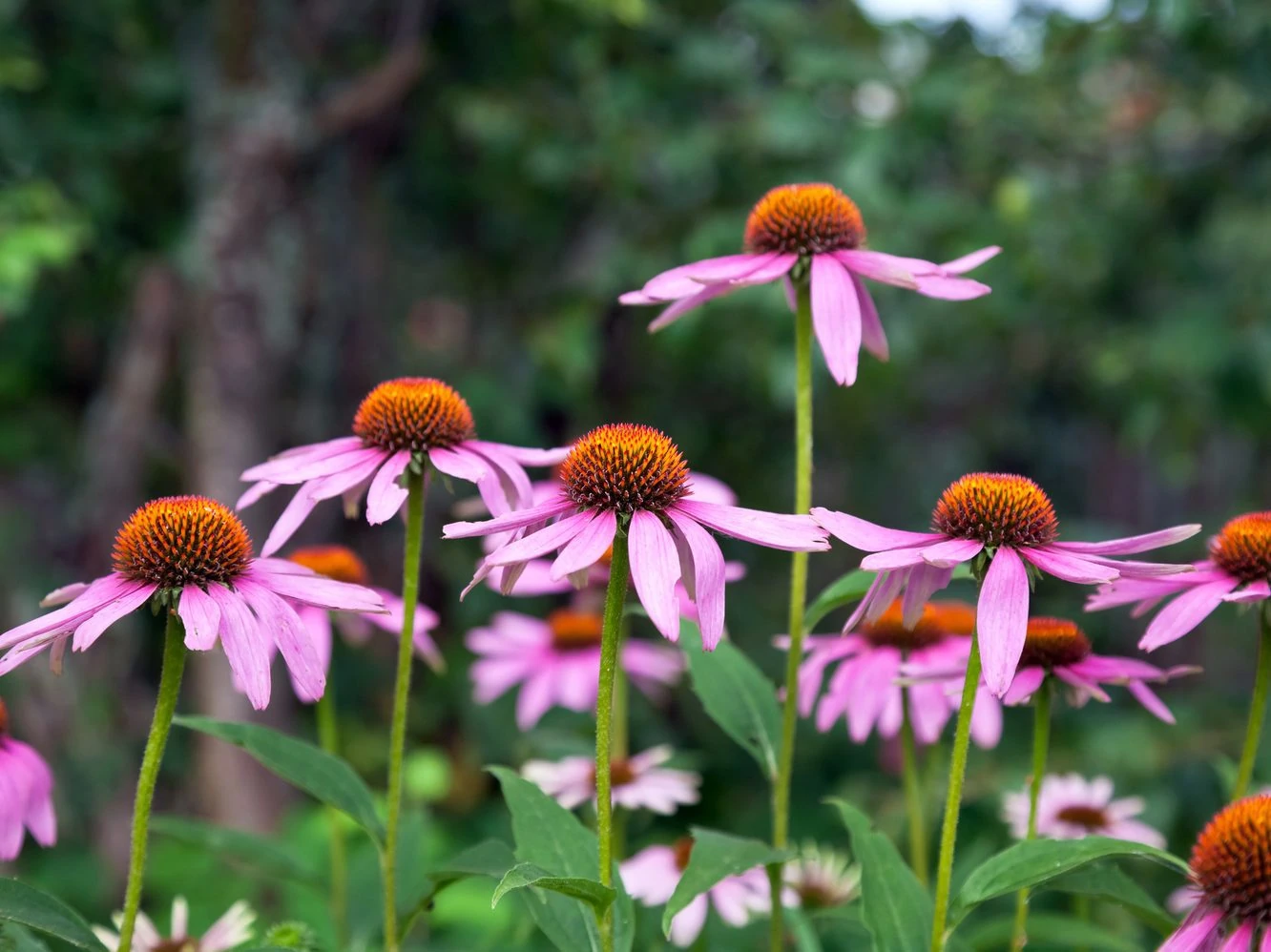
Coneflower is the common name for Echinacea, a genus of flowering plants that belong to the daisy family, Asteraceae. Their scientific name, Echinacea, stands for “sea urchin” in Greek because of their shiny central disk.
There are ten species of coneflowers, named so because their petals tend to point downwards once the central flower head opens, thus forming the shape of a cone. The most common backyard ornamental coneflower is Echinacea purpurea, or the purple coneflower, which is a native of eastern North America.
Coneflowers are large, about 6 inches across, and their stalks reach about 5 feet high. There are other colors available, like pink, red, orange, yellow, and white, depending on the variety. They love being in full sun, like 6 hours daily, and prefer to have well-drained soil. When these conditions are met, you’ll enjoy the flowers from summer to fall.
The brightly colored flowers, particularly the reds and purples, attract hummingbirds and other pollinators like bees and butterflies repeatedly. Their central cone is nectar-rich, and that draws them for a feast.
- Common Name: coneflower
- Scientific Name: Echinacea
- Growing Zones: 3 – 9
- Sun: Full Sun
- Soil: varies
- Colors: white, yellow, orange, pink, red, purple, green
- Height: 2 to 5 feet tall
- Spread: 1 ½ – 2 feet wide
- Plant Type: Perennial
24. Phlox
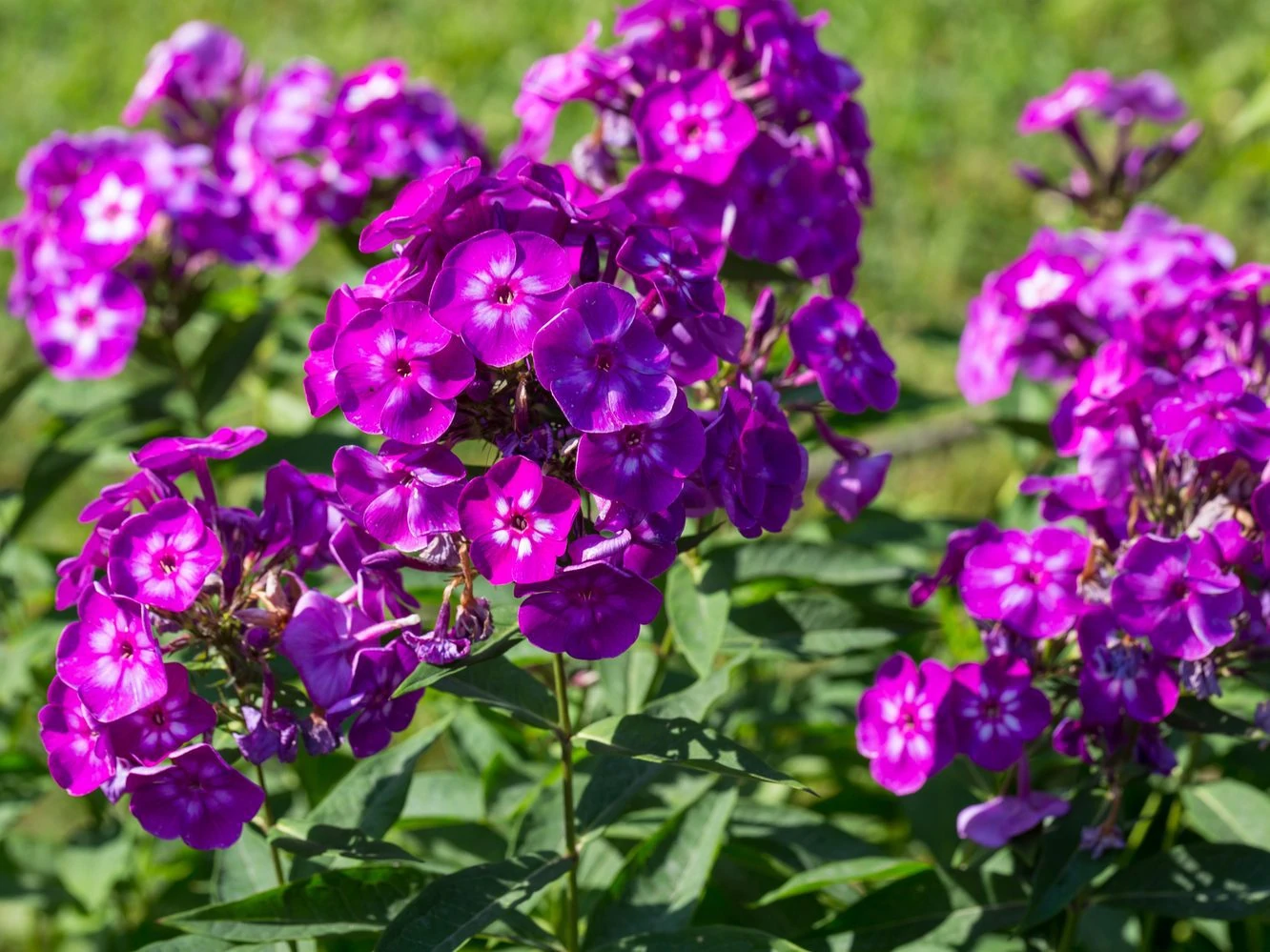
Phlox is a genus of flowering plants whose name is from a Greek word for “Flame” because of its intensely-colored flowers. While there are many varieties, it commonly has three types: Creeping Phlox (Phlox subulata), Woodland Phlox (Phlox stolonifera/divaricata), and Garden Phlox (Phlox paniculata).
Creeping Phlox grow low and wide, close to the ground, which is why they’re perfect as ground covers. Woodland Phlox are of medium height, so they’re usually best for filling gaps. Garden Phlox plants grow tall and erect, so even if they’re at the back, they usually stand out.
Phlox flowers are dainty and grow in clusters of twelve at the top of hardy stems. Most of the flowers are fragrant. Some flower in the spring, others in summer until fall. With many varieties, there are also many colors to choose from, like shades of white, pink, red, purple, and blue.
Since they flower profusely, sometimes it’s hard to appreciate their leaves because you hardly see them. But their leaves are also worthy of your attention. Some are oblong, pointed, and lance-shaped. Some even have border colors, but they’re mostly bright or deep green.
Regardless of their differences, they all attract hummingbirds and other pollinators. Luckily, they’re also easy to grow, and some can spread by self-seeding, so you really have nothing to do except give them the occasional water and let them have a full dose of sunlight.
- Common Name: Garden Phlox, Creeping Phlox, Woodland Phlox
- Scientific Name: Phlox
- Growing Zones: 2 – 9
- Sun: Full sun, part sun, shade
- Soil: Moist, fertile soil with a layer of compost
- Colors: white, pink, red, purple, blue
- Height: 4 to 6 inches, 8 to 12 inches, 2 to 4 feet tall
- Spread: 4 to 6 inches wide, 8 to 12 inches wide, 2 to 3 feet wide
- Plant Type: Perennial
25. Veronica
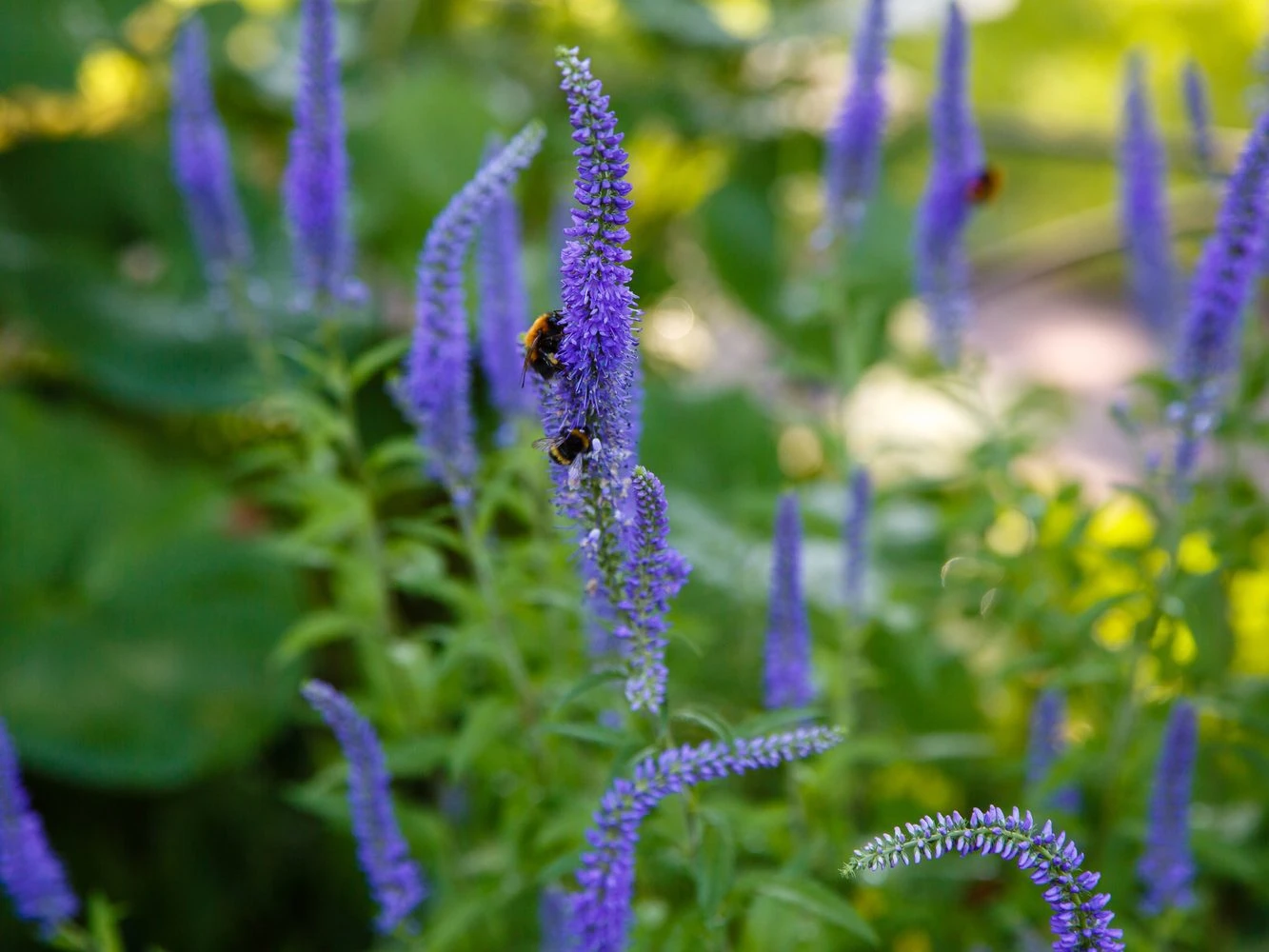
Veronicas are flowering plants that have about 500 species, making them the largest genus in the family Plantaginaceae. They are categorized as herbaceous annuals or perennials that are native to the temperate Northern Hemisphere.
Veronica plants come in many different varieties. Some are low-growing that are perfect as ground covers, and these tend to flower in the spring. However, some also grow tall and high with upright, vertical flower spikes, and these bloom during the summer.
Of the many Veronica varieties, Veronica spicata is one of the most popular. It is known for its colorful vertical spikes of flowers. These flowers are tiny and clumped at the end of the spike in colors of white, pink, purple, and blue. They’re attractive to hummingbirds, butterflies, and bees.
Speedwells, as they are also known, are hardy plants and will tolerate almost any kind of soil. They hardly have any pest problems, and when you deadhead them, you can extend their flowering season. They thrive in full sunlight but need to be watered regularly when they’re young to ensure the best flowers.
- Common Name: Veronica, Speedwell
- Scientific Name: genus Veronica from the family Plantaginaceae
- Growing Zones: 3 – 11
- Sun: Full sun, partial shade
- Soil: well-drained
- Colors: white, pink, purple, blue
- Height: 6 inches to 3 feet tall
- Spread: 6 inches to 2 feet wide
- Plant Type: Perennial

